

Converting a Monohull to a Trimaran .. and what to consider.
I have an old monohull with sound structure that I now plan to convert to a trimaran. What aspects should I consider when selecting suitable amas (floats) and what sort of performance might I expect ? Mark, New Zealand
This is perhaps the most frequent question I've received over the last 10 years of running this Q&A service. Here is some personal advice on the subject.
First, the owner must accept that the performance of the final boat will not match that of a custom-designed trimaran. That center hull will be proportionally wider at the waterline than would be a trimaran vaka (main hull), and even the keel profile will typically be far more 'banana' shape with the result that there's less directional stability and more pitching. Water surface will also be higher and the monohull will not be at ease being pushed much faster, so main hull waves will limit maximum speed compared to that of an equivalent length trimaran. Upwind performance will vary a lot, depending on the final choice of amas, how broad is the central hull and the windage it creates. The final converted boat will also be unlikely to garner much value so one cannot expect the same resale value as for a dedicated trimaran design.
But if the owner/builder can accept all the above, it IS possible to create a comfortable trimaran that heels less than it did as a monohull and also sail, at least in some directions, a little faster than it once did at the limiting hull speed of the original boat.
Here are some steps you will need to consider.
Conversion work on the Main Hull : Choice of Amas & Akas : Sail plan : and Rudders & Foils ... so let's look into each.
Ideally, the Main Hull (Length 'L') should ideally be relatively narrow and light, and permit the keel to be readily removed as this will no longer be required for stability. However, the trimaran will still need some lateral resistance so a centerboard of some type will be required. (my article on Foils might help on this). Obviously, the hull should be faired and closed-in the neatest way and with any lost strength compensated with the addition of adequate glass or carbon fiber to the shell laminate.
If the hull is very rounded, the low speed performance should be fine as long as the amas are not set too deep relative to the main hull (see below and read about dihedral here ) .... but if the main hull is too vee'd, expect it to be wet when pushed ..., or if the keel profile is too banana shaped, expect the boat to pitch considerably in waves and be more limited in speed.
You will need to choose the position of the cross beams, and the structure and arrangement of both the main hull and that of the chosen amas must be part of this decision. They should be a reasonable distance apart (say 35-45% of the main hull length) to keep the stresses acceptable in the connections.
Re the choice of Amas , this will depend on the type of sailing you enjoy and seek. Smaller amas (say 0.75L) will support less sail area but will allow the boat to heel more enabling wind to escape, as well as needing less strength from their akas If you are prepared to ease off the sail as soon as the leeward ama goes 80% under, you will stay safe and be unlikely to capsize. However, if you want more power, amas up to 100%L and with buoyancy over 100% of the total weight will offer more power and add more speed potential, as long as the akas and their attachment to the main hull are designed with adequate strength. See this article on Aka design . As noted, I typically advise that the load on the forward aka beam end be taken as the maximum buoyancy offered by the ama, even if this includes a margin for most normal sailing needs.
One aspect that I consider important that others may not, is that I would personally seek a visual match of the chosen amas with the main hull. A main hull with a large bow overhang can look ungainly with amas that have more vertical stems, even though the boat may still sail acceptably. From the performance point of view, amas that have straighter keels (like the newer beach cats, compared to the earlier H14 and H16) work better and help to reduce pitching. Ideally, you want the center of the ama volume (the center of buoyancy) to be well forward as this helps to prevent pitch-poling and if different from the main hull, can also help to reduce pitching. Positioning the ama bow well forward will also help to resist pitch-poling.
In profile, unless trials prove otherwise, it's generally a fair initial assumption to place the sheer line of the ama parallel to the sheer line of the main hull. In terms of the ama height, this is more determined by the location of the ama keel relative to the waterline. If the ama keel is placed slightly below the static waterline, the stability of the ama acts more quickly and the boat will therefore feel more stable. But the additional ama drag can slow the boat in light winds. Contrarily, if the ama keel is positioned to be above the water-surface, the boat will be fast in light winds but will feel unsettlingly jittery until it heels enough to put one ama a few centimeter's into the water. The compromise I most often aim for myself, is to have the ama keels 'just' kissing the static water surface with the main hull fairly lightly loaded. Ultimately it's for each designer/builder to make their choice as each decision will be a compromise. Light racing boats may have amas a little higher, but loaded cruising boats will almost always have their ama keels underwater. Boats with higher amas (like the Buccaneers of Lock Crowther) will allow the boats to heel much more before the amas 'get-to-work'. While this heeling will lower the sail power that can be applied to the boat to drive it faster, it also unloads excessive wind load from the sails that can save it from capsize. With fast boats that have their amas at the waterlevel, the best way to avoid capsize will generally be to reduce sail ..., and/or to have some semi-automatic way to release the mainsheet .. but that's a whole new subject ;)
The actual Aka (or cross beam) could be made from a pipe or mast section (aluminum or carbon fiber), or from fabricated wood beams. But either way, the deck edge of the main hull will need to be reinforced over a reasonable distance to adequately spread this upwards load, down into the side of the main hull.
The Sail Plan could either be from the original main hull ..., or even from the boat donating its amas ... such as a beach cat.
But remember that 1) sails on a multihull generally need to be cut a little flatter than for a monohull and 2) the stability of a trimaran will increase the load on both the mast and sails, so if coming from a beach cat, it's recommended to cut down its mast length to not exceed 1.35L of the original beach-cat length .... or if from the main hull, consider a max of 1.25L of the main hull. Of course, if you have the means to calculate the actual mast strength relative to the boat's stability, then you may be able to slightly exceed these figures, but without that, I would recommend to stay within them.
The final thing noted above are the Foils . Some means to limit lateral sliding of the boat will be required, and this need will be more with a banana-profile hull than with one that has a deep forefoot and relatively straight keel. Some guidance on a suitable area will be found here. The rudder of the original hull will likely be more than adequate, but you may want to modify its profile to bring a little area forward of the rudder-stock (pivot) to lighten its feel. Just 10-12% of the total area forward of the pivot can make a significant difference in feel and the pleasure of sailing.
Good luck with your conversion if you go this route .. and feel invited to send me some pics that I can then add here if they show something of pertinent interest.
"New articles, comments and references will be added periodically as new questions are answered and other info comes in relative to this subject, so you're invited to revisit and participate." —webmaster
"See the Copyright Information & Legal Disclaimer page for copyright info and use of ANY part of this text or article"
J-24 Sailboat Converted to a Trimaran
by Small Tri Guy | Oct 19, 2012 | Production/Commercial Small Trimarans , Small Tri Info - All , Small Trimaran Videos | 13 comments
Our small tri friend Stefano M. sent me links to the following YouTube videos. They feature a J-24 sailboat converted into full-blown trimaran.
The sailor(s) responsible for this appear to have done a fine job. Converting a monohull into a trimaran has certainly been done before. But it’s not for the faint of heart :-)
One really needs to know that they’re doing if ever attempting to do such a thing. There are so many things that can go wrong (structurally speaking).
One of the replies to the first video on YouTube indicates the amas are converted Hobie 20 hulls. This idea is naturally attractive to anyone who dreads an all-out boat building experience.
I’d love to know what mods were done, especially with regards to the lead keel … and the interior/cabin structure supporting the crossbeams. And was the mast reinforced? The stress on a multihull rig is generally much greater than on a mono.
There are also questions about how a boat performs after being converted into a tri. Does it still tack nicely? How well does it point? Etc.
Anyhow, perhaps we’ll find out as time goes by. (And thanks to Stefano for these vids!)
Update – 01/16/15: The owner of this boat, Delane, saw this post and shares some specific details about the building-conversion of this boat in the “Comments” area below.
___________________________________________________________
13 Comments
Can this please be the final nail in the coffin for the idea that all successful trimaran main hulls *must* be long and skinny for the boat to perform and/or track?
Nobody seems to be manhandling the controls and the boat is obviously moving quite nicely in not a ton of wind…and the J 24 hull is 24′ LOA with a whopping 8.9 feet of beam. That’s tubby even by mono standards, but fast because it’s light and has very minimal draft (low wetted surface) and very flat aft sections like a motorboat so it can surf/plane even as a monohull hauling an extra 950 lbs or so of ballast and 3-5 crew.
This thing doesn’t even have purpose designed amas and in the middle video you can see it accelerating and beginning to surf/plane and there’s hardly any whitecaps and no big swell, just wind waves…I guarantee you that boat is faster there than my Cross 24 would have been, and that boat was no slouch for its size and designed from scratch by a true master and design innovator.
Throw off those “long and skinny is best” shackles and full displacement thinking and there’s a world of monohulls out there that would make excellent tri main hulls, that are already exceedingly fast in their own right whether on plane or not…and were designed by a true master and design innovator as well-
http://www.flying15.org.uk/flying15/about.asp
http://www.sail-world.com/USA/index.cfm?SEID=0&Nid=40824&SRCID=0&ntid=0&tickeruid=0&tickerCID=0
“It is anticipated the hull and deck will weigh around 1000 lbs. ”
a 33 foot FRP over foam boat that sans rig weighs barely more than what a stock J-24 carries as dead ballast weight, with an even more “correct” length to beam ratio than the J boat ( it’s still narrower than the J)…all in a boat that planes already as a ballasted monohull- food for thought.
speaking of Uffa Fox and tri hulls- this one looks like a tri already, just missing its amas…and could use the same sized donor amas as the J 24-
http://1001boats.blogspot.com/2012/06/fairey-atlanta.html
Ian wrote: Can this please be the final nail in the coffin for the idea that all successful trimaran main hulls *must* be long and skinny for the boat to perform and/or track?
Well, probably yes…although from some other sites it may appear that this idea risks to be buried alive (check on w17 site for example). Other previous nails may well be magnum 21 trimaran (I personally measured a 1:6.3 bwl/lwl ratio, and perhaps what Farrier writes of his own tris: from TT 720 through F 27 to recent F 22: flatter run and wider (and a higher sail/dspl ratio).
My own experience tells me that with little power (kayaks, lesser canvassed proa or tris) having a sleek long hull ( 1:10 ratio) with some angle to get on a plane on a small wave set may be beneficial, but it really needs to be narrow and long.
A fatter hull needs more power. So if you do not intend to deal with tall masts and plenty canvas ( like more or much more than 30 sqm per metric tonne) , you’d probably be better off with a sleek hull with a flat run aft perhaps.
I’m drawing my own tri a 22 ft. It is a design that needs to strike a balance between ease of construction, ease of conduction and performances, including carrying 450 kgs payload ( 1000 lbs on 22 ft). It will have some dihedral forward, to help get some lift to get on a plane, it will have a 1:9 bwl/lwl ratio roughly, not too much rocker – about 1 ft over 22 – and it will have a flat and wider aft run, carrying the mid ship section all the way back. It will carry 26 sqm of sail upwind, over 2000 lbs ( 0,9 metric tonnes fully loaded) roughly a 30: 1 sail/dspl ratio, but then it will have a gennaker and a 52: 1 ratio downwind or on a broad reach in lighter winds. In brief, I’m trying to get inspired by semi planing one step hulls of the beginning of XXth century with ( I hope) a target cruising speed capable of reaching the low teens with the mentioned modest power in a beaufort 3-4 (Mediterranean summer breeze). The amas will hopefully be two dart 18 hulls (we need to get them from the seller yet) thus capable of a more powerful rig should need be.
ANYONE THERE WITH A SPEED PREDICTION PROGRAMME WILLING TO CHECK ON THE ABOVE MENTIONED FIGURES ? I’d love to receive some feedback before cutting the plywood. Bye to all, Stefano
Hi Stefano-
The hull you describe sounds very much like the type of boat I’m talking about with the beam carried far aft…assuming that it has very little hull draft and the runs are kept very flat it should be very easily driven even at fairly wide dimensions whether it is truly on plane or not.
I totally agree with you about kayaks and canoes being optimized for low power but I think the length/beam ratio is maybe getting more credit than it deserves as far as why these boats can make good small tri center hulls- they also are built very light as a rule and that makes for good tri building in general, and maybe even more importantly they are both hulls designed to remain upright in use, rather than working best when heeled over like many long, skinny sailboat designs of the past.
That’s a huge part of what might or might not make a good monohull conversion and a lot of skinny mono hull width is about self righting from knockdowns and seahandling when heeled as much as it is about speed potential.
Now of course when you say “canoe” most people in the US think of Indians paddling on rivers…but even with double ended canoe designs Uffa Fox managed to get them to plane very early on and knew exactly what he was doing-
“…Flying Fish has the longest length and smallest beam permissible under the rules, and as can be seen from the lines, these dimensions produce a very easy and sweet-lined canoe. But when we look at the lines of these light and very fast sailing hulls we must always bear in mind that they plane two-thirds of the way around a triangular course, and even close reaching will get up and scoot along the top of the water, and for this reason their lines must be studied from a different viewpoint than that taken when studying an ordinary sailing craft.
The sections are V’d forward, and are gradually flattened as they go aft where they are almost flat. The buttock lines also carry this out for they come down steeply forward, and then run aft almost parallel with the keel line, this giving the long flat run, necessary for planing.”
http://www.intcanoe.org/iclife/hist/uffa_flying_fish.html
note that the hull draft on this boat is 5 inches…there’s hardly any boat there at all, and that’s sitting still.
here’s more-
“Canoes sailing to windward or in light weather are travelling at a speed equal to the square root of their waterline length, or slower with the chine aft out of water. At such a low speed, the minimum wetted surface is important, so she has a round bilge for three quarters of her length.
Off the wind in a fresh breeze, or a wind of greater force, she travels at up to four times the square root of her waterline; then it is that the chine aft tells its tale, for where the water clings to a round, it cuts clean away from a sharp corner. The chine also extends the planing bottom outwards and gives greater planing power.”
http://www.intcanoe.org/iclife/hist/uffa_sailing_boats.html
I don’t know that the above qualifies as a speed predicting program, but if Uffa Fox says you can do 4X theoretical hull speed in semi planing mode, then I’d be inclined to believe him…regardless you seem to be on the same path that he was and modern materials and a tri platform shouldn’t do anything but help.
here’s a neat video of some international canoes in action-
http://www.youtube.com/watch?v=Exb6i3E3r-4
very speedy in pretty light air and the hiking plank makes it exactly like a tri if the amas fell off and the guy is trying to get back to the dock before it capsizes…why not just put some amas back on and relax?
Most interesting to me is the planing ability despite the relatively narrow double ended designs, which is a function of the boats having a very different bow and stern sections that look like a maxi ocean racer bow grafted onto a wide pin tailed surfboard with very hard rails (a chine). The difference between the super fine exits of traditional paddle canoes and kayaks and this flatter wider exit is the difference between hitting hull speed easily with man sized power input and then hitting a wall no matter how much more power you apply, or exceeding theoretical hull speed easily and regularly even with relatively small amounts of sail area.
In the video, also note the almost complete absence of rooster tails or any visible stern wave or wake, and very little bouncing compared to similar sized racing skiffs going really fast…there’s obviously a lot more going on here than meets the eye when it comes to what will/won’t plane or go fast, and how to do it…these boats obviously use the power they harness very efficiently and would seem to be an ideal candidate for grafting some appropriate small beach cat hulls onto for a smoking performance tri conversion…
I can see this-
http://www.sailnut.com/international-10-meter-canoe
with one of these as ama donor-
http://nswptca.papertigercatamaran.org/gallery.html
-making a very exciting under 250 lb 17 ft performance tri that would be a million times easier and more comfortable to sail than the canoe (or the cat) alone and would still be ultra fast for its size, for not a ton of money compared to anything else that would give you that kind of performance potential.
It could satisfy the go fast planing hull types as well as the people who like the traditional pointy boats with fine exits.
You could also build from scratch in ply-
http://www.internationalcanoe.yachting.org.au/?Page=24752&MenuID=How_to%2F13919%2F0%2F%2CBuild_an_IC%2F13920%2F0%2F
I wish to thank Ian for his fast and informed ( as always) comment. After posting my comment, I did some research on semi-planing hulls and yes, the graphs show that the figures range in between 3 and 4 times the square root of lwl expressed in ft. (A small digression here: I am amazed at how many graphs and formulas do not express the measurement units nor the axis meanings. I would not have got past junior high school if I did such a thing, which explains much of our scientists success when they migrate to find better jobs).
So… square root of a 22 footer lwl is 4,69 and the predicted speed thus would fall in between 14 and 18.8 knots.
Personally, I will take anything close to 10 knots in 3-4 beaufort as a big success, especiually it the huls will not pound too much ( other reason for putinng a V section forward) since I ignore in figures what a ” flat run aft” is ( mine will be 10-12 inches rocker), the dihedral angle that would be best for “lift” ( I will ask the sail maker to draw a gennaker with some lift power though) and what “reduced wetted surface” would mean. In fact, with my old PC programme ” plyboats 2″ I am trying to get the best figure of wetted surface/displacement at a maximum heel of 8 degrees. I also ignore what the step should be like, but I’ll check this stuff on a closeby museum that has many planes and hydroplanes hulls with steps on show. I also read that steps in the hull create an intended turbulence mixing water and air so to reduce friction drag from hull/water ( high) to hull/water+air ( lower).
I’ll strive to make the whole tri at least pleasing to the eye since thing I really loved in Uffa Fox boats is their looks, especially Atalanta. So again Ian, thanks for sharing :-) I hope here my Italian eye trained to beauty will help in the effort.
Yours friendly, Stefano
For Ian again…
Reading and quoting Uffa Fox from the same article on flying 15 lines:
(…) So while I think these lines we are now looking at are very fast indeed, I do not think they are fast round a course, and the moral of all this is that designers must put into the hands of helmsmen instruments, which, while being fast, are well within their capabilities, so that plenty of spare energy, both mental and physical, is kept in reserve, for the planning of their race and the sailing of it, enabling them to conduct operations in a seamarlike manner rather than in a state of feverish excitement throughout ” (Uffa Fox)
I wish I knew this man !! The bottom line of good handling and “manners” at sea are totally within my design goals and priorities, and stand higher than maximum speed overall.
Again thanks for sharing… Stefano
I truly envy your being able to go visit a museum full of Italian seaplanes, which are without a doubt some of the most beautiful machines of any kind ever created…and in the case of this one, still the fastest propeller driven seaplane in the world since 1933-
http://upload.wikimedia.org/wikipedia/commons/thumb/c/cf/Macchi_M.C.72.jpg/800px-Macchi_M.C.72.jpg
http://img577.imageshack.us/img577/4917/italianafmuseum132.jpg
I think you are correct about the air induction aspect of stepped hulls being a major reason for using them on fast planing powerboats…on a float plane float that’s some of it, but not so much for speed potential as for helping to quickly break free from the water surface entirely, the same way steps on three point hydroplanes do.
But on a float plane float some of the step design there and especially the aft sections with the extreme fine exit and very upwardly angled straight rocker aft of the step are all about nose high trim attitudes on takeoff and especially landings…a really flared nose high landing means that the aft section of the float becomes the entry point and a wide flat planing hull shape here could potentially trip the entire machine and slap it down on the water hard enough to destroy it…when you look at it this way you see that the aft section of a float is really more like a bow pointing backwards.
So there’s some stuff that is directly applicable, and other stuff that isn’t unless your ama is regularly breaking free of the water and re-entering it (like in big seas), which it very well might and a plane float style ama and step might make perfect sense.
Another thing to consider is that step placement fore/aft can affect overall pitch trim when underway because the air/water mix behind it is less buoyant. On a powerboat with a step and wide transom, this has the benefit of causing the stern to sink slightly into this foamy mixture and assume a better trim for planing when underway, but still have a full depth transom. On a float plane it means that as you apply power the step makes the plane assume a more nose high trim needed to take off and the grip of the water on the float lessens.
When angled other than 90º to the hull, steps can also induce a turning moment…some deep vees do this on outer chines, to help fatter boats turn better as they roll onto that section of hull that is designed to always turn.
On a heavily canvassed tri I can see this kind of asymetrical step being used on an ama to counteract negative helm tendencies as the hull is pressed harder and engages the step, which might allow larger less balanced rigs without strenuous helm input to control them going to weather…but what really intrigues me is the idea of using a directional step on the main hull to not just affect that hull but to also direct and modify the flow of its wake so as to optimize the flow that the ama works in/on…
a step in the main hull will bring the stern wave more forward, which puts the amas in a position to surf naturally on that wave if they are shaped and positioned properly…it’s not that you are making more power, just re-harnessing some of what was used to make that wave in the first place.
This “ama surfing the main hull wake” idea has been used on some of the big power tris like Earthrace/Ady Gil that have the amas very far aft and tucked into the main hull wake…if you look at this pic-
http://www.barking-moonbat.com/images/uploads/earthrace2.jpg
you can see a bit of this positioning- imagine wanting to catch that stern wave on a surfboard and you would want to be paddling hard right about where that ama is sitting, which is that magic point where the wave takes over and you are riding it.
at speed it’s even more dramatic-
http://www.sail-world.com/photos/Alt_Earthrace%20finishes.jpg
the amas are just buried in that stern wave, again very similar to the attitude a surfboard takes right before it uses that stored energy of being sunk to pop forward and plane right along as long as there’s a wave.
hard to do that with a sailing boat that needs the width for stability and more ama buoyancy forward…but a step in the main hull might bring that wave forward enough to get some of that effect on a more traditional sailing tri hull layout.
The Tricote trimaran is another beautiful “monohull to trimaran” conversion – http://www.tricote.fr/construction.php
I’m the designer and builder of the Tri conversion. Going on a short vacation soon, but after I return I can submit a summary of the project from the beginning to it’s current design. I built a hump under the main Vaka, lower the Amas and repositioned the rudder to the right side and was ready to launch and then a Typhoon flipped it off the trailer, breaking the mast, destroying one of the Amas and a couple of holes in the deck and a bit of damage at the new plumb bob bow. I’ve done nothing since the disaster but want to bring her back to life. Was so close to trying out the newly modified hull design that by my estimation would have increased performance by at least 20 to 25% depending on point of sail. I’ll be back with more.
Please do ! it will be our opening new year bonus! Looking forward to the insights…
best luck for this project, Stefano
Most of the project details are on a forum called Boatdesign.net under the multihull section. Search for Hobie/J-24 Tri Conversion Project. The first step was to cut off the keel and then glass up the stub that was left. The beams go through and are supported by 4 fiberglass boxes. The mast was converted to a tabernacle so that I could de-mast during Typhoons. She sails great to windward with the boards down or up. The center fixed dagger board was fabricated using a a 6mm steel plate, spiderboard foam aircraft wing – NACA 2210 if memory is correct. It is very solid. Can go into detail on that more if you like. She tacks on a dime. Very neutral on the helm. You can’t let go of the helm more than 3 seconds. Check out the site, and I’ll post some updated photos of the last hull mod to the center Vaka. The day I recorded the video segments we saw 10.2 on the GPS and a few times I’m sure we hit 12 coming off of a wave set. I’m in the process of re-building after the disaster 2 years ago and can’t wait to see if the hull mod proves worth the effort. I did use additional flying wires attached to the front beams. Let me know if you have further questions. Also where can I upload some photos?
Hi Delane, Great to hear from you! Thanks for sharing some specific details about your conversion of this boat to a tri. You won’t be able to upload any photos here, but you can post URL links that link directly to each photo you want to share. In other words, just “direct link” to each photo so when someone clicks on the link the photo will open up in their web browser.
Delane Rivenbark
Is it possible to chat with you online to discuss that J24 Tri 24 you made. [email protected]
Submit a Comment
Your email address will not be published. Required fields are marked *
Notify me of followup comments via e-mail. You can also subscribe without commenting.
Blog Post Categories
- Production/Commercial Small Trimarans (291)
- Self-built Small Trimarans (678)
- Small Trimaran Audios (30)
- Small Trimaran Videos (289)
- Trimaran Design, Rigging, Construction Info/Links (222)
- Contact “Small Tri Guy”

- Subscribe Now
- Digital Editions

The best of both worlds? Introducing the world’s first trimonoran Project Escalade
- Superyachts
- Top stories
A radical new foiling hull design claims to combine the efficiency of a trimaran with the space of a monohull — Hugo Andreae takes a look at the world’s first trimonoran motoryacht.
Award-winning Turkish yacht designer Baran Akalin has combined forces with Dutch engineer G. Jelle Bilkert to create what they describe as the world’s first ‘trimonoran’. As the name suggests it is based on a ground-breaking new hull design that claims to offer the efficiency and stability of a trimaran with the speed and volume of a monohull.
Instead of three slender vertical hulls linked by spars or a beamy main deck, the two outer hulls fan out at an angle from the central hull like the segments of an orange. These are linked below the waterline with hydrofoils to create the necessary lift for planing without the associated drag and unforgiving ride of a big, beamy monohull.
The idea was originally drafted by Dutch naval architect G. Jelle Bilkert some time ago but has now been refined, developed and tank tested with the aid of Dutch government funding into a fully patented production concept by Dutch company AnwigemA BV. Budding Turkish yacht designer Baran Akalin, who won a design award last year for his futuristic steampunk superyacht concept , saw its potential as the basis and has further developed the idea into a striking new luxury motoryacht concept named Escalade.

Tank testing of the scale model proved its potential
Fast and efficient
The benefits of this new low drag design are said to include speed gains of up to 30% over a conventional monohull, excellent stability both under way and at rest, large deck and hull spaces and superior fuel efficiency at cruising speeds leading to a greater range.
Recommended videos for you
The principal is much the same as a trimaran in as far as the slender central hull generates less drag than a single beamy monohull design and slices cleanly through waves for a softer more efficient ride. The two outer hulls then provide the lateral stability as well as the extra volume and deck space needed to house the accommodation.
However, unlike a conventional multihull, it doesn’t come with the penalty of an excessively wide beam that makes it hard to fit into marina berths, nor the small planing surfaces that require huge amounts of power to generate enough lift to make it plane.
Article continues below…
Steampunk superyacht takes yacht design back to the future
Leen 72 first look: cutting-edge trimaran launched by neel yachts.
The key to this new trimonoran design is the addition of two foils linking the front and stern sections of the outer hulls. These not only provide lift but also reduce drag to enable the kind of planing speeds not normally possible with this size and style of yacht. Another break from tradition is the adoption of a hydraulic link to transfer power between the engines and the propellers rather than a conventional shaft.
This allows the engines to be positioned amidships to keep the weight as low and central as possible while the propellers are mounted on the aft foil to keep them immersed at all times. The only physical link between the two are the high pressure hoses which feed hydraulic fluid from the main engines to the small hydraulic motors and shafts in the foil. Sealegs amphibious boats use a similar system to feed hydraulic power from the petrol generator mounted under the helm seat to the folding wheels on the transom.
Size not compromise
Akalin’s current design for Escalade is based on an LOA of 82ft (25m) with a beam of 32ft 8in (10m). This is almost double the width of a comparable monohull such as the Princess 82 (18ft 10in) but still usefully slimmer than a similar length of powercat such as the Sunreef Power 80 (39ft 4in).

Vast main deck makes the most of its 32ft beam with central seating on a raised plinth
This length-to-beam ratio creates enough volume on the lower decks for four cabins and four bathrooms including a large master suite in the bow and an additional two-person crew cabin. However, the big wins are on the main and flybridge decks, both of which benefit from the extra floor space enabled by that 32ft beam.
The main deck incorporates a large open plan living area with a galley on the starboard side and a lounge area to port, in the middle of the yacht on a slightly raised plinth is a central seating and dining area with uninterrupted views out both sides. Doors out to the side decks as well as the cockpit encourage an easy flow of people and air through the yacht. The styling of the interior is the work of British designer Celia Sawyer.
Access to the flybridge is via a central staircase which passes under a glass-bottomed jacuzzi that allows light to filter down into the cockpit below as well as a unique view for its occupants of the wake trailing out behind. Multiple sunpads on the flybridge, in the aft cockpit and on the foredeck ensure it’s every bit as luxurious as a conventional monohull while its futuristic looks are a far cry from the rather dumpy looks of some multihull designs.
Although only a concept at this stage Akalin is confident Escalade could be turned into a viable production or semi-custom superyacht at a price that would allow it to compete with monohulls of similar volume.
First published in the October 2020 issue of Motor Boat & Yachting.
Project Escalade features a radical new trimonoran hull
Designer baran akalin penned its futuristic lines, the three hulls are linked by foils at the bow and stern, the new ‘transformer’ megayacht concept that expands at anchor, a spectacular west country rib adventure in search of tall ships, princess f58 first look: bigger, better equipped and more luxurious, latest videos, saxdor 400 gtc tour: düsseldorf launch for new flagship, arksen 85 explorer tour: the ultimate long-range cruiser, sacs rebel 50 tour: the world’s most luxurious rib, fairline targa tour: sensational new british sportscruiser.
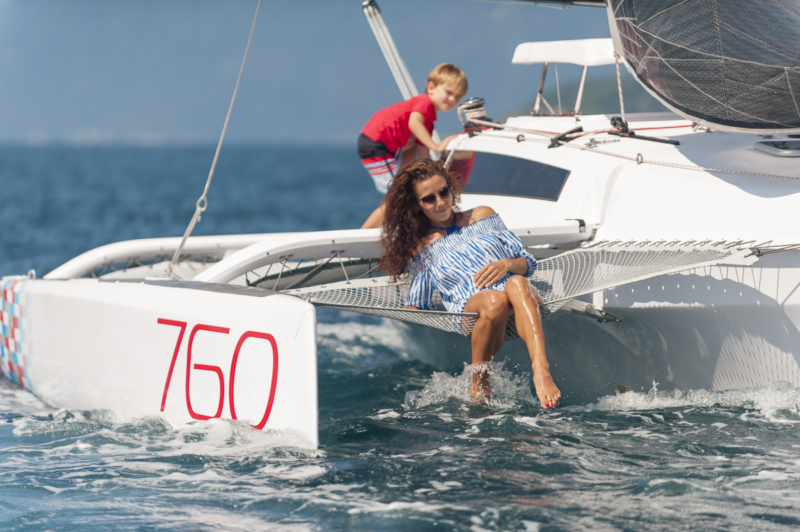
Why Choose a Trimaran over a Monohull?
Why choose a trimaran over a monohull:.
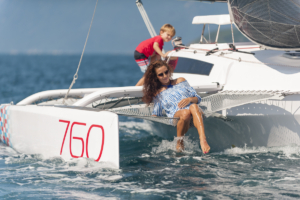
Corsair Trimarans provide safe sailing excitement for the whole family
The first item on this list might surprise you. But trimarans are exceedingly safe – in fact many, including all of the Corsair trimarans , are virtually unsinkable. They’re foam cored, and relative to the displacement of the boat, the buoyancy of the materials is very high. Even were a Corsair to be fairly well destroyed (think passenger ferry) the remaining debris would remain at the surface providing something to cling onto. But there are some other interesting stats as well. Kids love trimarans – the nets make for great fun. And were they to fall into the water its reassuring that there are so many places for a person (or child) overboard to grab onto – see the net lines and the beams themselves in the picture to the right. There are also good places at the main transom to haul out a wet, heavy, miniature crewmember.
No gimmicks. Trimarans simply deliver stunning speed without foils, wings or electronic aids. Speed might have slipped from number 1 factor to number 2 in recent years – and given the advent of foiling monohulls you might think that’s fitting. But consider the costs involved in foiling monohulls and you’ll quickly find that Corsair trimarans have a far greater dollar-to-knot ratio. Operationally, trimarans are now seen as almost conventional in high-speed terms. So you can clock up 20-knot plus speeds with a boat that has a 35-year track record of success and safety, and without the need for professional crew.
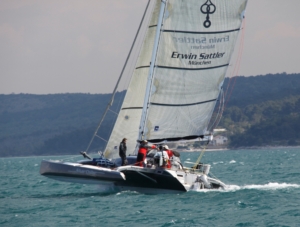
For a trimaran, this counts as “heeling”
While you, the reader are no doubt the hardiest of sailors, there’s also no doubt that not everybody you sail with will be! Corsair trimarans, and most others, have a max heel angle of 12-14 degrees depending on the model. That’s “flat sailing” in monohull terms. And it means that rudders and daggerboards keep a reassuring grip and the speed therefore feels more effortless on the helm. That surefootedness transfers over to your crew – they’ll detect the confidence in the boat and the skipper.
Small Marina Footprint

Fold up and take only a small marina berth or land space
To achieve anything like the speed, and just a bit of the stability and comfort underway, you’d need a relatively large monohull by comparison. But due to the folding mechanism, a Corsair trimaran keeps a very modest marina footprint. Better still, they can be lifted (when folded) and are therefore easy to keep ashore. Want to keep your boat in the water but worried about growth on the floats/pontoons? Anti-fouling wraps from 3M are available from Corsair dealers – remarkably long lived, these are easily replaceable, and maintain a very quick surface. Boat bags, which keep growth away from the floats and main hull, are available for mooring and marina use.
Above Deck Space
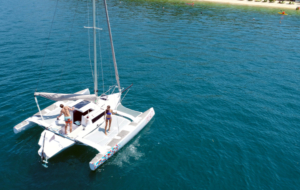
Check out the huge unfolded beam of the 24-ft Corsair 760
Anyone with children will immediately identify with this one – Corsairs are fantastic for their wingnet and bownet space. When unfolded, the huge beam provides pound-for-pound the best boating platform around. The nets are often used as sleeping hammocks in extremely hot climates – not just for an afternoon nap, but actually during the night. And most trimarans can be fitted with a bimini, sail shade, or canopee when the sun is strong.
Trimarans are Synonymous with Trailerability
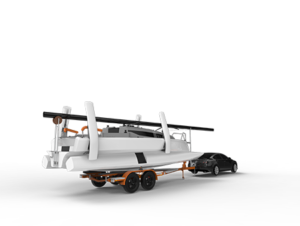
The new Corsair 880 Trimaran will be the Ultimate Trailer-sailer
In the next article, we’re taking a deeper look at trailering trimarans through an interview with the undisputed supremo in trailering tri’s – our very own dealer Werner Stolz from Germany. Trailerability is absolutely central to creating a new holiday experience every year, and for the racers it opens up a whole new world of high speed multihull regattas. That’s why Corsair trimarans are built light – of course it improves your sailing speed, but it also keeps your trailering weight down and reduce road risk. And that’s why the floats fold underneath – so your boat doesn’t get longer on the trailer when folded. For those who don’t want to commit to the same sailing grounds every year there’s no better solution than a Corsair folding trimaran.
Trimaran docking made easy
Corsair 28R won third place in Kieler Woche 2019
Corsair 880 design news
Share This Story, Choose Your Platform!
Related posts.
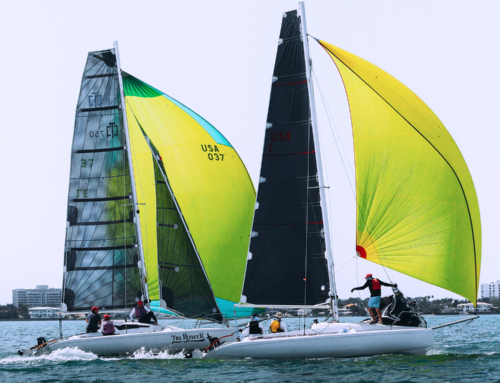
Corsair Regionals 2022 Recap
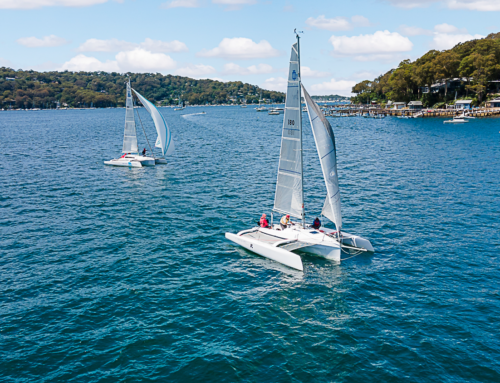
Corsair & Seawind Pittwater Regatta 2022

Corsair 880 Trimaran 2021 Review by SAIL Magazine
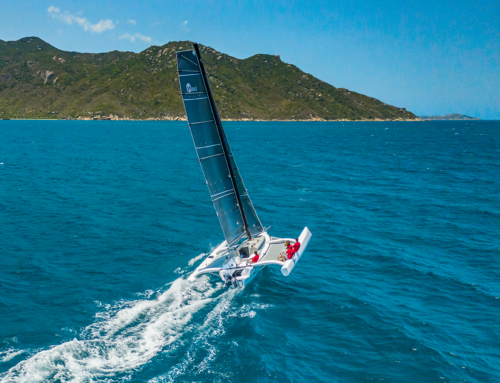
Seeing Triple – Multihull Trimarans Redefine Sailing With Speed & Agility

The current situation at Corsair Marine
Yachting Monthly
- Digital edition

Wow, that was fast! Why trimarans are SO much fun to sail – and how to do it
- Theo Stocker
- February 13, 2024
For their size, trimarans can punch well above their weight in speed, cruising potential and fun. Monohull sailor Theo Stocker gets to grips with how to handle one
Humans tend to gravitate into tribes of like-minded enthusiasts, enjoying the encouragement, support and sense of identity, while often looking askance at others; sailors at motorboaters, cruising sailors at racers, monohull sailors at raft, I mean, multihull sailors, and everyone looks askance at jet-skiers.
Large cruising catamarans (40ft now counts as a small one) are a world apart from monohull sailing, but there’s a sub-tribe of sailors dedicated to life on three hulls and builders such as Dragonfly, Corsair, Farrier, and Astus give them plenty of choice.
I’ve been sailing a 22ft (7m) Astus 22.5 this season, with just enough space for a family of four and a minimum of creature comforts. Thanks to her VPLP-designed hulls and 650kg all-up weight, we can sail upwind at 7-plus knots and downwind at over 10 knots with ease, all on a roughly even keel, while the kids play Duplo down below. It can also be beached and is towable behind a car.
Having, it seems, caught the trimaran bug, I wanted to get better at sailing and handling the boat, but my monohull sailing experience and habits were proving something of a hindrance, so we sought advice from some existing trimaran owners, and well as the UK’s top multihull sailors.
Much of the advice will apply to all multihulls , whether two or three-hulled, while other parts are just for small trimarans. I also found that brushing-up some of my rusty dinghy sailing skills helped get my head around what we were trying to do.
To try out our expert tips we went out sailing to see what difference they made. On the day, we got a solid Force 4-5 southwesterly, averaging 16 knots, but fluctuating between 12 and 20 knots true.
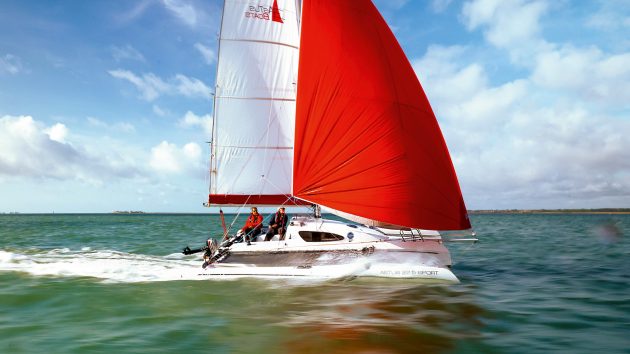
Blasting about on a sporty trimaran is a whole world of fun, but is much calmer than it looks
Trimaran sail trim
One of the biggest differences between a cruising monohull and a multihull is how the mainsail is trimmed. Leech tension on a yacht is often largely controlled by the kicker and the backstay, while the mainsheet sheets the mainsail in and out, predominantly controlling the angle of the boom to the centreline, and there may be a short traveller.
On a mulithull, however, there’s more than enough space for a good, wide traveller. Those who sail on performance monohulls will also be used to this. The sail shape is mainly controlled by the mainsheet, and the traveller then moves the boom towards or away from the centreline.
This is exaggerated on a multihull which has wide shrouds, swept well aft with no backstay, making space for a powerful square-top mainsail with full-length battens. There’s no backstay to bend the mast and flatten what is anyway a pretty rigid mainsail.
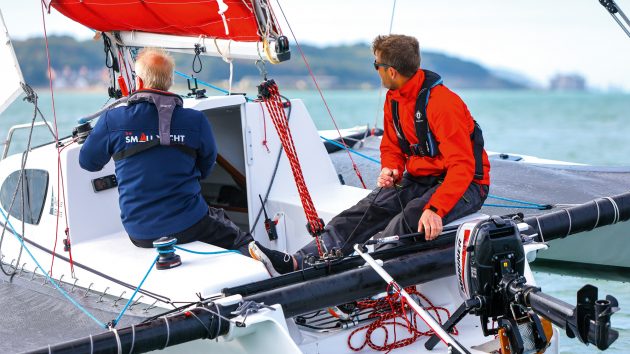
The mainsheet purchase creates enough power to control the leech of the square-top mainsail
Depowering a trimaran
Sailing on a monohull, heel and weatherhelm and eventually a broach give loads of warning that you’re pushing too hard. With straight hulls and little heel, those warning signs don’t really apply to multihulls.
In reality, however, there are a host of warning signals that it’s time to back-off; they’re just a bit different. Even then, there’s still a large safety margin before you get close to danger.
By way of reassurance, with the boat powered up on a beat, Hein, from Boats on Wheels, the boat’s owner, stood on the leeward hull and lent on the shrouds. Even as his feet got wet and the wind gusted at the top of Force 4, the boat didn’t bat an eyelid, thanks to the huge buoyancy of the floats.
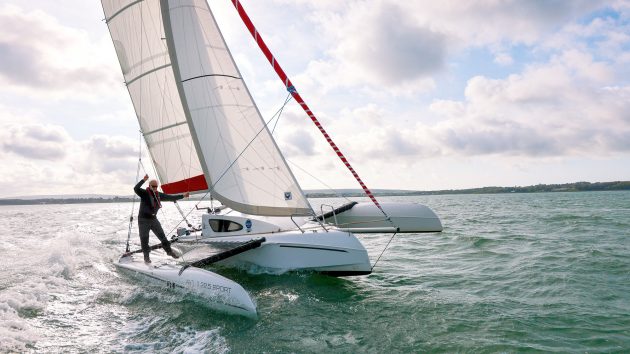
Even with a person on the leeward float the boat was extremely stable
On the water – sail trim
My first inclination was to point the boat as high upwind as possible, pin the sails in and go for height. Doing that resulted in a not-terrible boat speed of 5-6 knots and a good pointing angle.
Free off by a handful of degrees however, and ease the sails just a smidge, and the speed leapt up to 8-9 knots – over 50% more; a huge increase. So, don’t pinch. If you had a decent chartplotter on board, you could find your optimum speed to angle using velocity made good (VMG).
I was also tempted to pinch in the gusts, but it’s better to hold your course and let the speed increase until the main needs easing.
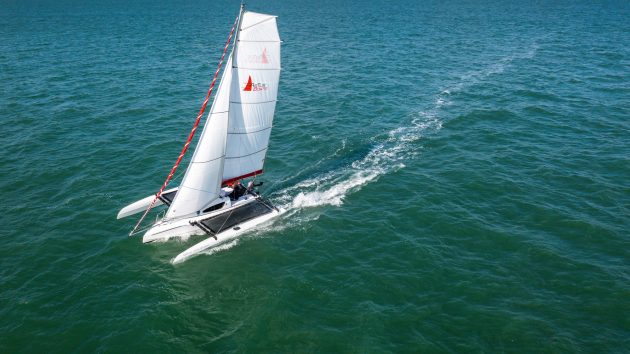
On the wind, it’s time to get the boat fully powered up
If that’s the case, drop the main down the traveller an inch or two or ease some twist into the mainsail and it makes all the difference in the world, but not so far that the top battens fall away and invert – that really isn’t fast. Push too hard and the boat will slow down, largely from the drag of submerging the leeward float and crossbeams. If you’re still overpowered and the main is luffing, it’s time to reef. Downwind is different, but we’ll get onto that later.
After we put a reef in the main, our boat speeds upwind remained largely the same, and the boat was much happier. I came away feeling reassured that even a little trimaran like this would be pretty difficult to capsize, and there were always plenty of warning signs telling me to take my foot off the pedal a little.
Article continues below…

Catamaran sailing skills: Mooring and anchoring a multihull
How do you make an average passage speed of 7 knots, fit in three double cabins and a huge saloon…

Monohull or multihull: which is best for blue water?
As former editor of Yachting World, David Glenn has plenty of experience of both monohull and multihull cruising. Here he…
Tacking and gybing a trimaran
Everyone knows that multihulls don’t tack as well as monohulls. Straight hulls and wide beam don’t lend themselves to turning, especially when coupled with the displacement and fixed keels of big cats. Trimarans are a little easier, with a single central daggerboard to act as a pivot, and one or other of the floats will generally be clear of the water. On the downside, light displacement means that there isn’t much momentum to keep you going through the turn and plenty of windage to stop you.
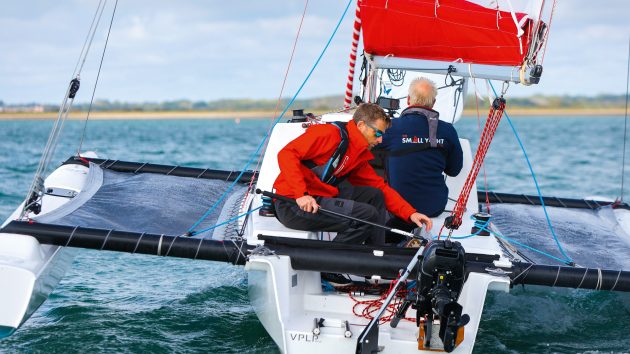
On a trimaran the central daggerboard helps the boat to turn by providing a central pivot point that catamarans lack
Speed is your friend. Build speed up before the tack to give you as much momentum as possible. The helm needs to steer positively into and through the turn, and if necessary, keep the jib backed on the new windward side to help the bow through the wind. Don’t worry about scrubbing speed off, but you don’t want to get stuck in irons.
When it comes to gybing, speed is again key. The turning bit isn’t going to be an issue as you’ll be scooting along, but the faster you’re going, the less load there will be on the sails. The more you slow down, the more the true wind will pile up.
Trimaran sailing skills
Tacks took a bit of practice. It felt plain wrong to jab the tiller across the boat, slamming a big break on in the water but I ended up putting us through the tacks far too slowly, losing a lot of speed. A more aggressive approach worked better. On the Astus, the traveller was between me and the tiller, so the tiller extension needed to be swung around the stern behind the mainsheet onto the new side.
Similarly, old habits of controlling a gybe needed to be modified. With the asymmetric set, we were planing at well over 10 knots, and the ideal is to stay on the plane. Heading dead downwind and centring the main lead to a more violent manoeuvre than flying into the gybe as fast as possible and, as the boom was never that far out thanks to the apparent wind angle, it didn’t need much extra controlling.
Coming up onto the wind after the gybe helped the asymmetric around the front of the jib and to fill on the new side. Stay too deep and it’ll get blanketed by the main. Once we had built up some apparent wind, we could bear away again.
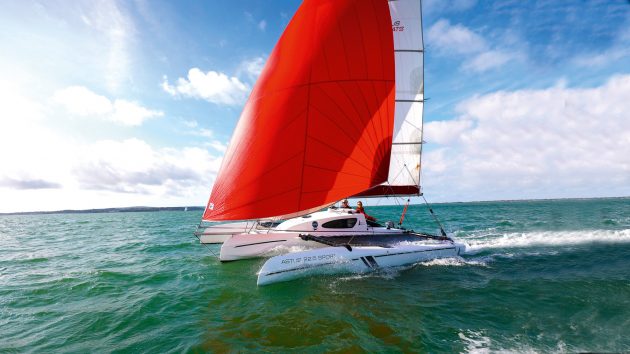
You’ll be on a course deep downwind before you know it, hitting speeds in the double digits
Downwind in a trimaran
Upwind cruising may be fun in a multihull, but bearing away and going with the wind is what it’s all about. Easily-driven hulls, a generous sailplan and light weight mean you can be up and planing, leaving displacement boats wallowing in your wake.
The big difference comes from apparent wind. If you’re in a boat that can do 15 knots downwind in 20 knots of true wind, the resulting wind angles can really mess with your head.
To get going then, says Brian Thompson, ‘Use those leech tell-tales again when sailing downwind and reaching to set the correct twist through the mainsheet, and use the traveller to set the correct angle of the whole sail to the wind.’
As the wind and your speed builds, bear away and trim the main accordingly.
In theory, you shouldn’t need to ease the traveller at all, but you may need to if you want to sail deep downwind. As the gust fades, you’ll find the boat slows down, so you can come back up towards the wind a little to pick up some more breeze, and then bear away as you accelerate again.

Bear away as the boat accelerates. Your course will be something of a slalom as you look to keep a consistent wind angle
This results in something of a ‘slalom’ course, and will also be accentuated if you’re sailing down waves, but that’s all quite normal for apparent wind sailing. Ultimately, you’re looking for a consistent apparent wind angle, even if the resulting wake isn’t straight.
It’s worth remembering that apparent wind reduces the felt effect of the wind, so you need a sailplan to suit the true, not apparent wind speed.
I found that the boat was more sensitive to having a balanced sailplan and trim downwind than upwind, largely because you’ve got almost double the canvas up, with the bowsprit as an extra lever. When weather helm built, I needed to ease the mainsheet to increase twist to depower so that I could bear away. I must admit, getting the boat balanced, sailing fast and light on the helm at 15 knots was something I came away feeling I needed more practice at.
Reviewing the images, I suspect the asymmetric was sheeted in too hard, with too much twist in the main.
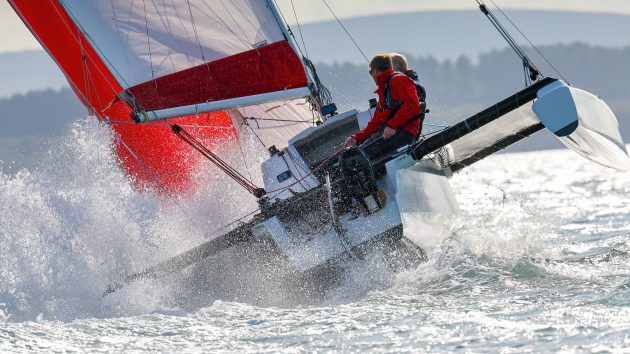
Getting a float fully submerged is when it’s time to back off
On the water
Unfurling the gennaker worked best on a beam reach, giving plenty of airflow over the sail to help it fully unfurl. This was also roughly the fastest point of sail, ideal for getting up some speed for apparent wind sailing. We mostly had the sails set for a close reach, even when we were beyond 120º off the true wind on a broad reach.
It was possible to soak deeper downwind, but lose the apparent wind benefit downwind and our speed dropped off dramatically, prompting us to point a bit higher to find some more speed.
As the boat powered up, it paid to hold a slightly higher angle than I would have done in a monohull for the boat to properly take off and get up into double digit speeds – topping out at 15 knots. Lymington to Cowes would have taken us just half an hour at that speed. It’s easy to give yourself a heck of a beat back!
We were sailing on a pretty flat day, so didn’t have to contend with any waves to speak of. On the recent RTI this is what caused the capsizes of at least two multis, a sobering reminder that you need to sail much more conservatively in lumpier conditions.
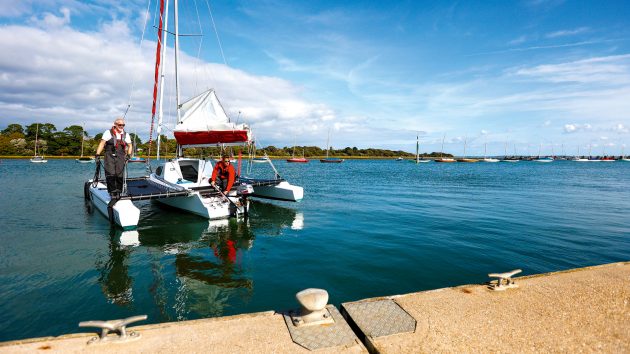
The bows want to point downwind, so a stern-first approach works with rather than against the boat
Coming alongside
A 650kg boat with no draught and plenty of windage feels dreadfully skittish when manoeuvring in confined spaces. Straight hulls with no forgiving curves and fragile-looking sharp bows make berthing tricky. You’ve got a couple of advantages on your side, however. In the Astus, the floats are at pontoon height making stepping off easy.
Whether you have an engine in each hull of a cat, or one in the central hull of a tri, there’s also a lot more leverage to play with to turn the boat and drive her on or off the pontoon. A steerable outboard gives you even more options.
If the boat has a lifting keel or daggerboards, put them down if there’s enough depth to give you a pivot and to resist drifting. Think about getting corners onto the pontoon, rather than putting the boat alongside. On tris, you won’t be able to get to the bow to fend off as it’s too narrow. You can rig a fender up forwards on a line, and two fenders are enough on the flat sides.
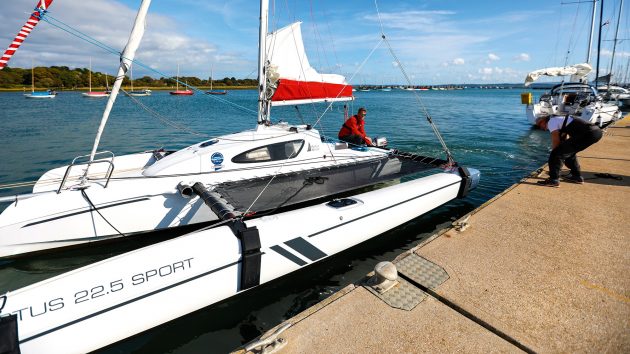
Steering with the outboard towards the pontoon will drive the stern in more; steer away to drive the bow in more
Offshore wind
Coming onto the pontoon with wind blowing off, it worked well coming in stern first. If there’s a tide running, you’ll want to be heading into the tide, so find a spot down wind and down tide to start your approach so you come in at an angle.
On our first attempt we had a bit of tide under us to start with so we came in at a much steeper angle, almost 90º, although this worked out OK in the end.
The crew could then step ashore, taking a line from the stern quarter round a cleat.
Drive forwards against the line and the bow will obediently drive up towards the pontoon, bringing you flat alongside. Getting off was simple, releasing the bowline, and allowing the bow to swing out the before slipping the stern line.
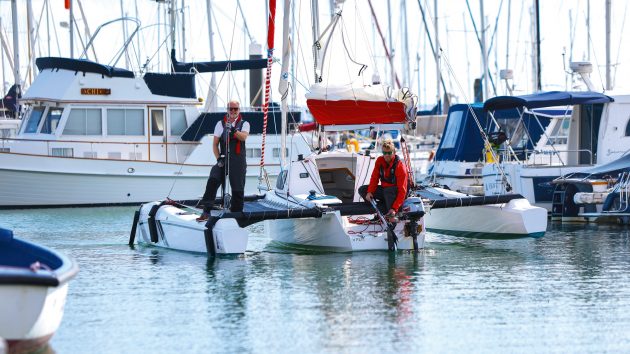
Coming in astern and stopping upwind of the berth meant the bows blew towards the pontoon far to quickly
Onshore wind
Getting onto and off a pontoon with onshore wind proved rather trickier. On our first attempt we came in stern first. The issue was that once we were just upwind of our desired berth and stopped, we lost steerage and the bow immediately blew off with alarming speed towards the pontoon.
Going ahead would only increase the force of the impact, while going astern only increased the bow’s sideways drift. I managed to back out without smashing the bow, but only just, and ended up awkwardly stern to the wind with the bows pointing at the pontoon.
On our second attempt we came in bows first but having aimed at the berth, I had to motor the stern to leeward to stop the bow hitting, making for a rather forceful coming alongside.
On take three, I came in forwards and began ferry gliding towards the berth early, keeping the bows to windward of the stern. Being able to steer with the outboard meant I could go ahead to keep the bow up, and go astern with the engine pulling the stern down toward the pontoon. In this way, it was possible to come in pretty well controlled and parallel to the berth.
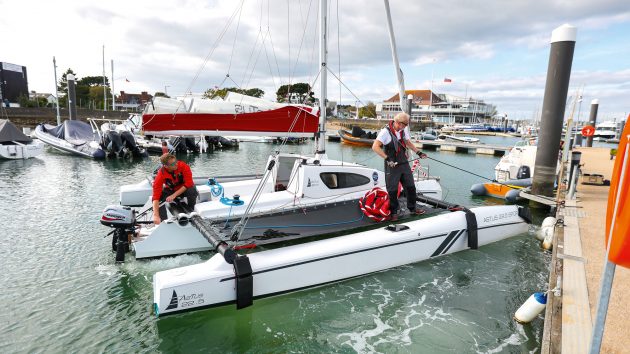
To get out, motoring astern against a bow line pulled the entire boat clear before slipping the line
Leaving was a different proposition all together, as I didn’t want to drag the bow along the pontoon, or to drive hard onto it to spring off. Instead, we rigged a slip-line from the forward cross beam. Going astern against this, and then turning the engine towards the wind, I could pull the stern, and the rest of the boat, out and away from the pontoon.
Keeping power on astern, once we’d reached a decent angle, we slipped the line and went astern, finding steerage way almost at once, with the bow following obediently in our wake with more control than I had anticipated.
Whether the wind is blowing onto, or off the pontoon, you want the engine to be driving or pulling the boat off the pontoon with a line on the corner you are going away from. That way you avoid point-loading fine ends where it’s hard to fender.
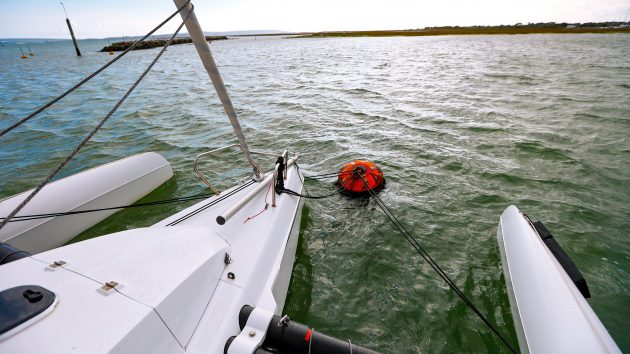
You’ll want a bridle to reduce swinging, but keep the pick up lines on the bow as backup
Anchoring and mooring a trimaran
While mooring a catamaran is complicated by the lack of a central bow, things should be simpler on a trimaran, and they are, mostly. Picking up a mooring buoy from the main hull bow with a low freeboard and dropping the pick-up line onto a cleat is easier even than a monohull.
The bow may be narrow, but for any lines that pass through a ring on the buoy, you still need to take it back to the same cleat to avoid chafe. That should be it, but windage from the two extra bows and the lack of keel mean the boat can dance merrily around the mooring buoy in a breeze.
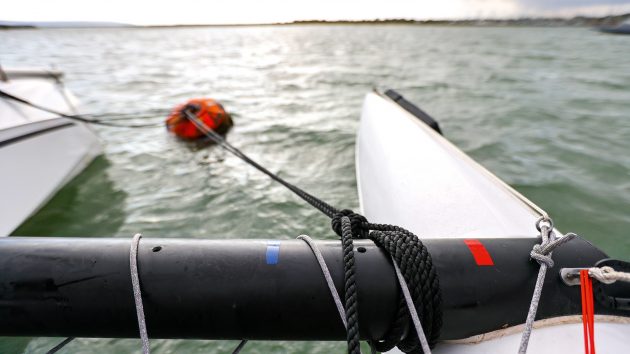
Rig the bridle so the buoy sits to one side to stabilise the boat
In practice, we found that a trimaran benefits from a mooring bridle in the same way that a catamaran does. It can’t be rigged from the floats’ bows, as there are no mooring cleats, so a line passed around the outboard ends of the forward beams gave a pretty good angle, again with long lines passed through the mooring and back to the same side. The main pick-up lines stay as a safety backup.
The other trick is to rig the bridle asymmetrically so that the buoy sits to one side or the other, just enough to not be dead head to wind, making it much more stable in the wind.
On the plus side, the lack of draught or keel means that you’ll nearly always be lying head to wind, so the cockpit remains nice and sheltered whatever the tide’s doing.
We ran out of time on the day to try anchoring, but rigging a bridle, effectively a long snubber to a point on the anchor chain in a similar way wouldn’t be tricky.
If you needed not to swing, or to behave more like deeper boats nearby, hanging a bucket over the stern can help, or there’s always anchoring with a kedge, either out ahead in a V, or in line astern.
Enjoyed reading this?
A subscription to Yachting Monthly magazine costs around 40% less than the cover price .
Print and digital editions are available through Magazines Direct – where you can also find the latest deals .
YM is packed with information to help you get the most from your time on the water.
- Take your seamanship to the next level with tips, advice and skills from our experts
- Impartial in-depth reviews of the latest yachts and equipment
- Cruising guides to help you reach those dream destinations
Follow us on Facebook , Twitter and Instagram.

Catamaran vs. Trimaran: The Differences Explained
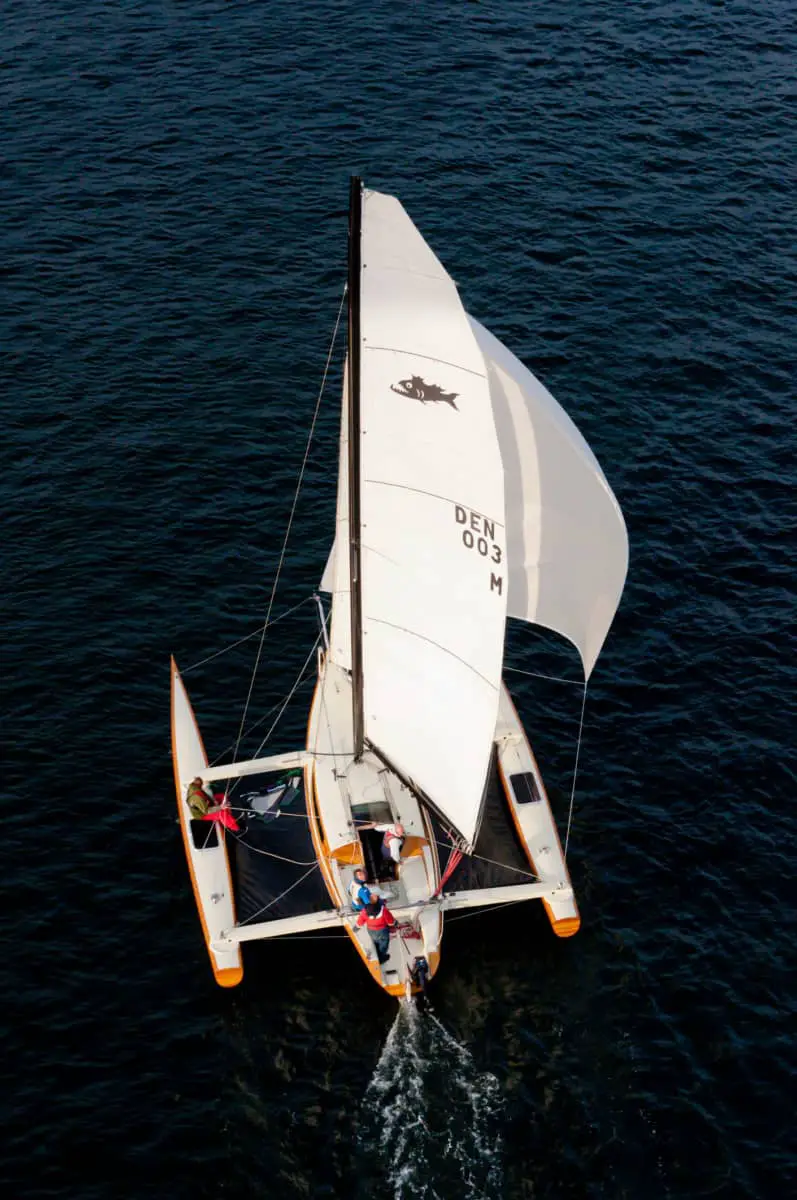
As an Amazon Associate, we earn from qualifying purchases. We may also earn commissions if you purchase products from other retailers after clicking on a link from our site.
Most boat lovers know the differences between a catamaran and a monohull. But when it comes to differentiating between a catamaran and a trimaran, things can get tricky because it’s not always clear how much difference the extra hull of a trimaran makes in performance, safety, comfort, and handling. If you’re trying to choose between the two, this is a post you’ll want to read before making a decision.
Besides the number of hulls catamarans(two) and trimarans(three) differ in speed, safety, accommodation, helming, and anchoring. Generally, catamarans are more manageable in a marina and provide better accommodation and comfort. Trimarans, on the other hand, are faster and more fun to helm.
In this post, we’ll cover these differences in greater detail to make it easier for you to choose between a catamaran and a trimaran. First, let’s quickly review each multihull type.
Table of Contents
The Lowdown on Catamarans
Informally dubbed a “cat,” a catamaran is a type of multi-hulled sailing craft with two equal-sized parallel hulls. Cats are typically geometry-stabilized, leveraging their wide beams for stability. That’s unlike monohull boats, which use ballasted keels for stability. Catamarans also have a smaller displacement, lower hull volume, and a much shallower draught ( draft ) than similarly sized monohulls.
The earliest forms of catamarans can be traced way back to the 17th century. They were primarily used for fishing by the Pavaras community in Tamil Nadu, who preferred them over other fishing vessels due to the extra balance and stability provided by the twin hulls. Later on, the British adopted the concept of twin-hulled boats and popularized it worldwide.
Modern catamarans are much more sophisticated than their ancestors. They’ve evolved in terms of the usage versatility, construction, and design, giving rise to two primary configurations:
- Small-Waterplane-Area Twin Hull (SWATH)
- Wave-piercing catamarans
The hulls in a catamaran with a SWATH configuration are typically submerged. That means they’re less affected by ocean waves , which is great for stability when sailing in rough waters. In the recent past, SWATH configurations have been used on research vessels and rescue ships.
Their wave-piercing counterparts, on the other hand, have low-buoyancy bows fitted on the twin hulls. The bows allow the hulls to puncture ocean waves instead of riding over them, making catamarans with such a design faster on rough waters than SWATH cats. In the recent past, wave-piercing cat designs have been used on passenger ferries, military vessels, and yachts.
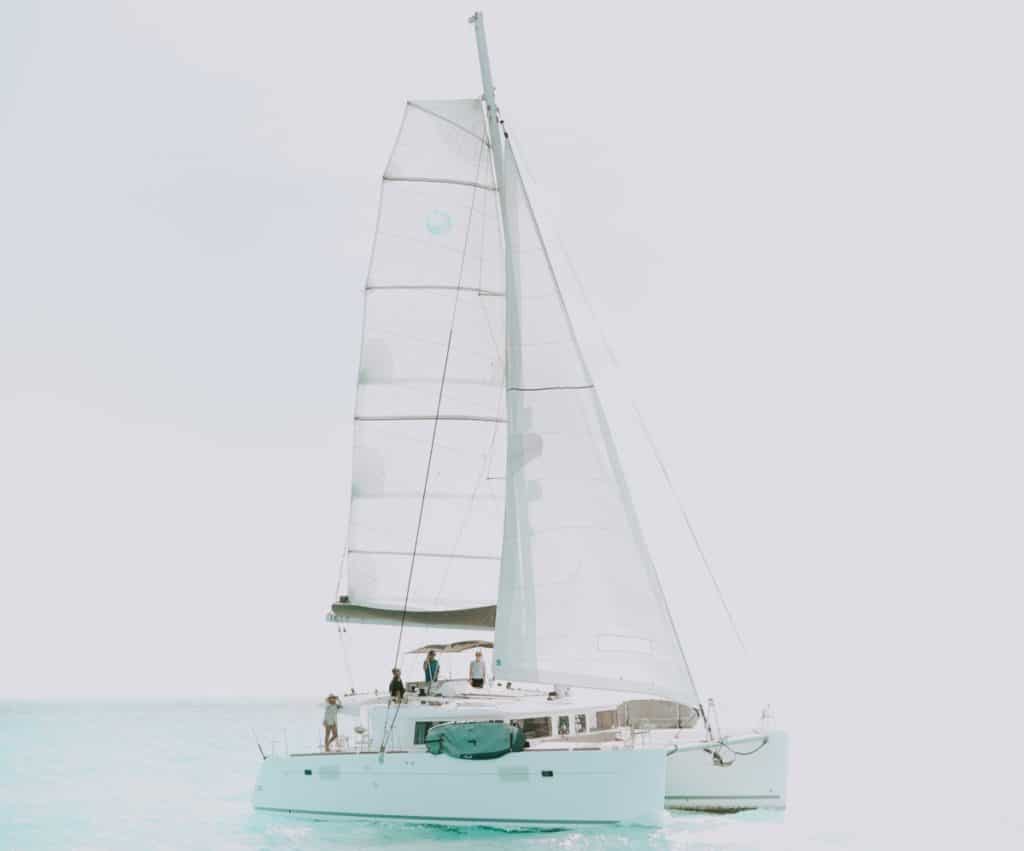
The Lowdown on Trimarans
Also known as a double-outrigger, a trimaran is a type of multihull boat with one main hull flanked by two smaller “floats” (technically known as outrigger hulls) connected to the larger hull by lateral beams. Such a design makes trimarans incredibly stable, meaning they’re hard to capsize even in the roughest of waters.
The earliest forms of trimarans can be traced to the Austronesian people and are still the most common hull design you’ll find on traditional fishing boats in Maritime Southeast Asia. The majority of today’s double outriggers are yachts meant for racing and recreation, but some warships and ferries have this design.
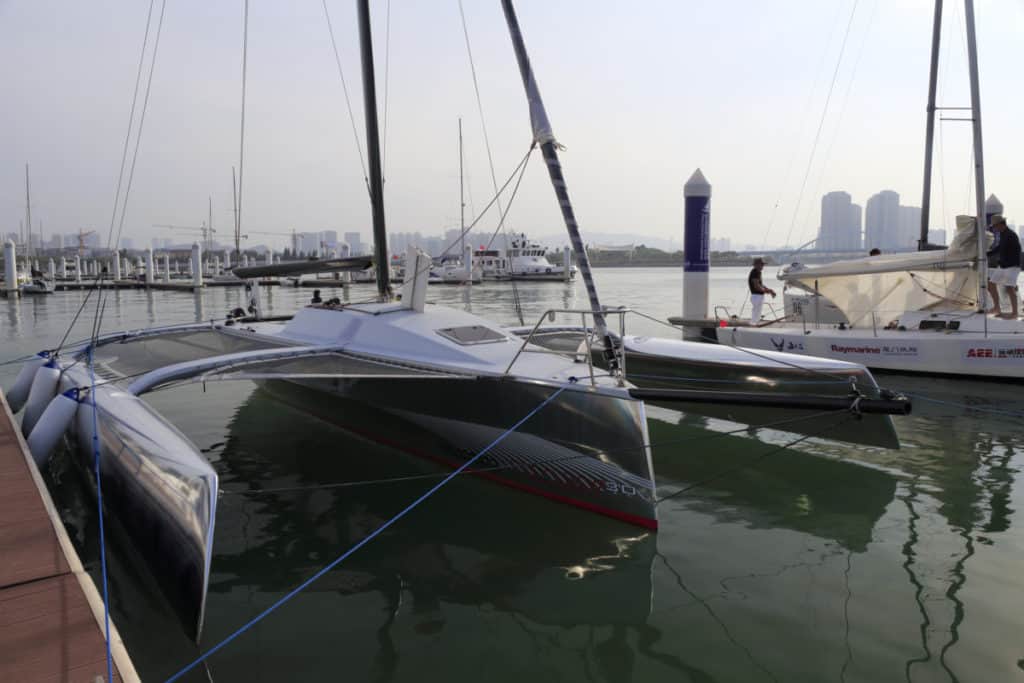
The Differences Between Catamarans and Trimarans
The most apparent physical distinction between a catamaran and a trimaran is that it has three hulls instead of two.
But other than that, are there other differences between the two vessel types you need to know? Do those differences make one type better than the other?
To find out, let’s compare the two types of multihulls based on the following merits:
Comfort and Accommodation
A Cat’s geometry is ideal for comfort and accommodation. The two load-bearing hulls provide additional habitable space, and you can always create a sizable nacelle between them. Connected to this central living space is a large cockpit, and there are cabins on either end of the hulls. This arrangement is perfect when you’re looking to relax a bit as the party rages on in the saloon because it gives you a bit of privacy.
And with flybridges virtually standard on modern catamarans, you have extra space for entertainment and lounging. The deck area is safe for kids, and the fact that catamarans don’t heel much means that you can do things like cooking at ease. Also worth mentioning is that cats can carry a decent load, meaning you can stock up on food and gear when going away for an extended period.
While trimarans do provide a decent degree of livability, they fall short of catamarans in two regards. First, they heel more than cats, making it difficult to do things like cooking on board. Second, they support much less load than catamarans. To put things into perspective, some 45 feet (14 meters). Cats can carry nearly three tons of payloads, whereas similarly sized trimarans can barely support half that load.
Overall, catamarans provide better, more comfortable accommodation than trimarans.
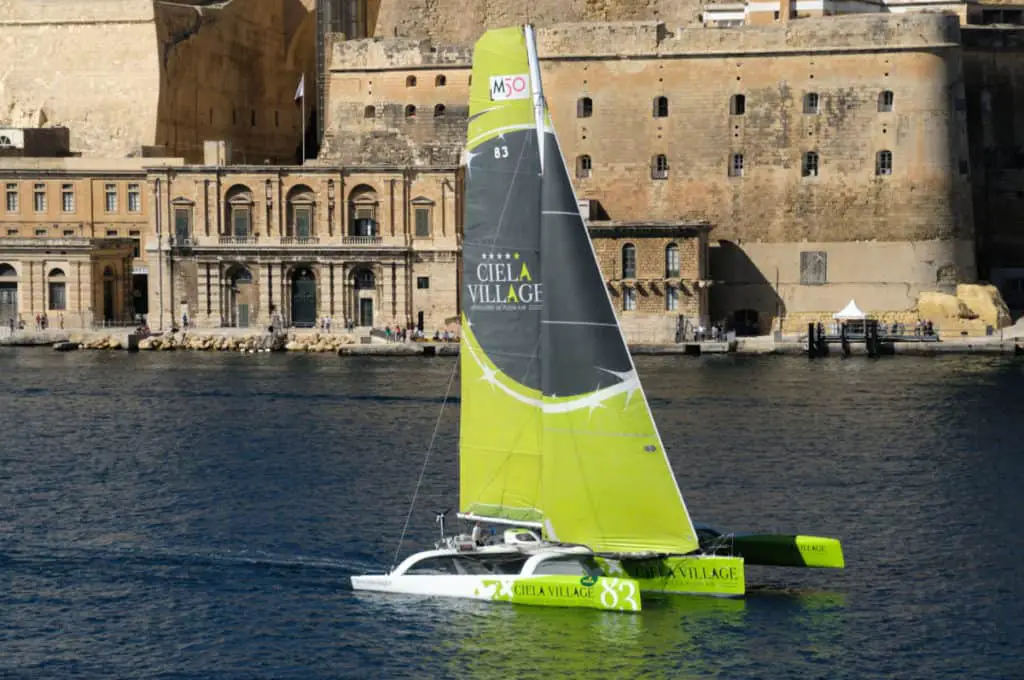
One of the main concerns when choosing any water vessel is how easy it’ll capsize in the event of a storm. If you’re looking to spend more than just a couple of hours on the water, you want to sail on something that won’t capsize/sink easily because sea conditions can sometimes fluctuate within a short period.
When it comes to safety, three hulls are better than two. Having one main hull and two overhangs on each side makes a trimaran more stable because of two reasons. First, the side overhangs widen the beam of the vessel, which minimizes the chances of the boat flipping over when hit by a large breaking wave from the side. Second, trimarans are typically designed with the weight centered on the main hull, further enhancing stability.
Multihull stability is a complex topic and should be understood in detail if you want to stay safe at sea!
- Why do catamarans capsize?
On the rare occasion that a trimaran flips over, it’ll stay afloat. That means if the worst happens, a capsized trimaran will turn into a potential life-saving raft that’s easier to spot from a helicopter. That’s because almost all trimarans designed in the last decade or so come with closed-cell foam distributed throughout the various parts of the boat to provide reserve buoyancy.
Thanks to this kind of construction, you could cut most trimarans into pieces, and each would still stay afloat.
While catamarans are typically more stable than monohulls, they’re no match for a trimaran in this regard. Hypothetically speaking, it would be easier to tip over a catamaran than a trimaran if both boat types were subjected to equal magnitude storms. That, however, doesn’t mean that catamarans aren’t safe. They’re still harder to flip over than monohulls and will stay afloat when that happens because they come with the same closed-cell foam found in a trimaran.
While on the subject of safety, it’s worth mentioning that trimarans require less vigilance as far as reefing is concerned . Since catamarans heel less, most of the extra wind force translates to more “push” on the rig, increasing speed. But because the pressure exerted on the sail nearly quadruples when the wind speed doubles, you need to be extremely careful when timing your reef to keep a cat sailing flat.
The same goes for reefing a trimaran, except that the slight heel gives you more room for error in terms of the timing.
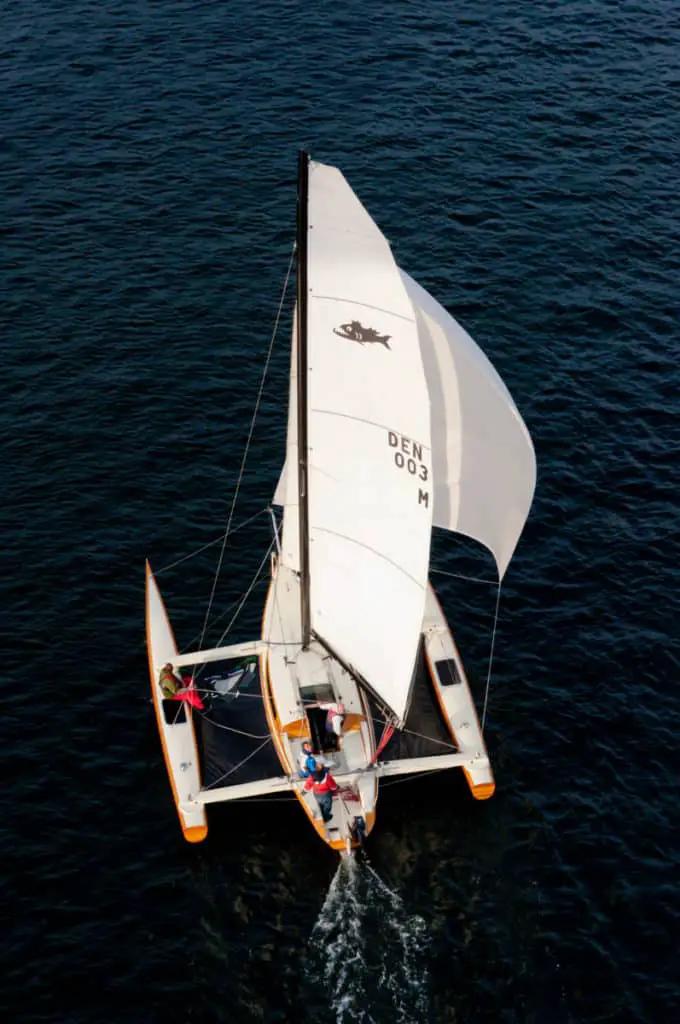
Most people who’ve ever steered both a trimaran and catamaran will agree that the former is more fun to sail. Most light trimarans, especially tiller-steered ones, have a terrific response to the helm. They have a slight heel that somewhat feels like a monohull, but the angle is a bit limited.
A catamaran is stable, but it doesn’t heel. While heeling may be frowned upon by people who prioritize comfort and accommodation in a boat, it’s one of the most exciting parts of sailing. With three hulls to ensure stability, trimarans combine the heel of a monohull with a catamaran’s stability to deliver the best sailing elements of monohulls and multihulls in a single package.
Considering that trimarans are more stable, you may be better off with one if you’re looking to have some fun as you perfect your helming skills.
Speed is another area where trimarans outperform their twin-hulled counterparts. Typically lighter than catamarans, trimarans need less sail distance to hit double-digit speed averages. A trimaran can maintain a formidable course up-wind when fitted with centerboards/daggerboards (as is often the case for modern models).
While a catamaran is still faster than a monohull of identical size, it falls short of the trimaran in terms of sheer speed. Understand that this doesn’t make catamarans slow boats; it’s just that tris are typically designed with more emphasis on performance.
Why are Trimarans Faster Than Catamarans?
Trimarans are easier to anchor than catamarans because they allow you to keep the ground tackle in and deploy it from the main hull.
However, catamarans are more maneuverable and manageable in a marina. They also handle docking lines more conveniently.
Catamarans vs. Trimaran: The Verdict
In summary, here’s what the differences between a cat and tri mean for anyone trying to choose between the two: A catamaran is a better choice if you’re looking to accommodate many people on board for something like a party because it’s more spacious and comfortable than a trimaran. On the other hand, a trimaran is an ideal choice for speed junkies and individuals looking to push their sailing skills to the next level on every stable platform.
Hopefully, that has cleared the air and made it easier for you to pick a more suitable option for your sailing needs.
- ResearchGate: A comparison of the motions of trimarans, catamarans and monohulls | Request PDF
- Why are trimarans faster than catamarans?
Owner of CatamaranFreedom.com. A minimalist that has lived in a caravan in Sweden, 35ft Monohull in the Bahamas, and right now in his self-built Van. He just started the next adventure, to circumnavigate the world on a Catamaran!
Leave a Reply Cancel reply
Your email address will not be published. Required fields are marked *
Save my name and email in this browser for the next time I comment.
Recent Posts
Must-Have Boat Gear for Catamaran Sailors!
Sailing is probably the most gear-intensive activity I've ever done; there are so many decisions to be made about what gear to buy now, for tomorrow, and what to definitely never buy. The gear on...
6 Best Trailerable Trimarans For Bluewater and Coastal Sailing
Having a boat costs a lot of money, even when you are not using it, marina fees, etc. And once it is in the water most sailors never go very far from their "home marina" and sailing will be somewhat...
- Outremer 45
- Outremer 4X
- Outremer 4.zero
- Outremer 52
- Outremer 55
- Outremer 51
- Outremer 5X
- All the Outremer Fleet
- Personalized support
- Blue Water Sailing Seminars
- Our concept
- The Outremer team
- Our commitments
- Construction principles
- Our catamaran services
- After-sales customer service & Quality control
- Offshore Connected Catamaran Maintenance
- Concierge Services
- Our owners’ stories
- FAQ – Outremer catamarans

- Brokerage: used catamarans for sale
- Privacy Policy
- Legal Notice
- Grand Large Yatching
Monohull to Multihull
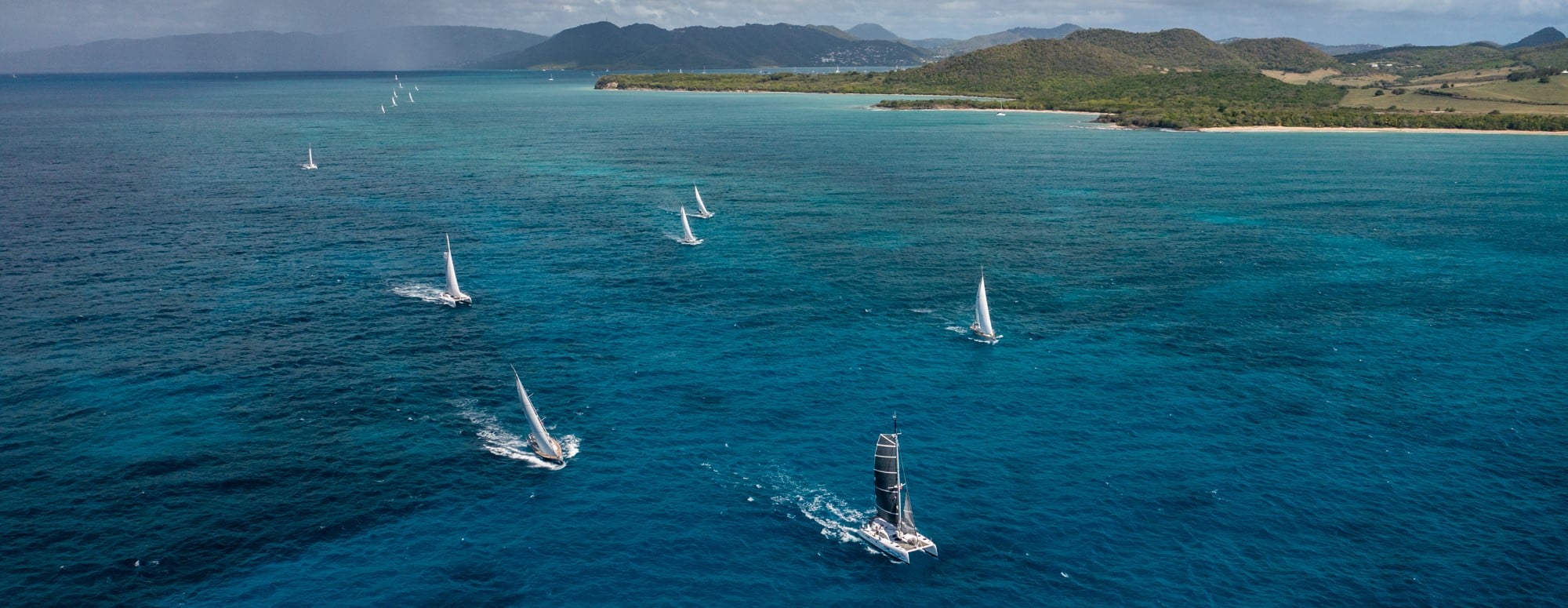
Author: Nikki Henderson
For most professional sailors, winters are characterised by wet, warm and windy caribbean racing. alas, covid19 brought an end to the usual scene back in 2020. saying that, i was lucky enough to head out west albeit in a more mellow fashion; i spent the month maintaining 59-norths’ 48’ and 59’ swan, managing their transition to commercial ocean-going vessels (‘cat-0 for anyone in the trade)..
If you are unfamiliar with Swan, they are one of the most famous monohull boatbuilders, renowned for their feminine lines and impeccable craftsmanship. However, they were not built to comply with the extensive commercial requirements of the 21st century such as the stipulation for water-tight bulkheads, hence my month working at anchor. For anyone owning an Outremer already, I can confirm that those bulkheads at the front were worth every hour that they added to the build time because added them decades later is no mean feat! Mission was successfully accomplished for anyone who is interested.
Aside from being fortunate enough to work on the water, one of the bonuses of the last month was my debut introduction to the life of a cruiser. That is … on the days that I wasn’t scrunched up in the bilge servicing engines with a leaking (found out too late) oil extractor pump, or other equally filthy jobs. It may surprise you to hear, that although I have spent the majority of the last 10 years at sea, I’ve barely tasted the cruising lifestyle. On the rare occasion that I’ve spent an evening on anchor, I’ve always had one of my hats one: as a racer – studying not the sunset, but how the wind funnels off the headland; as an instructor – considering not where the beach is, but the landmarks for our three-point-fix; as the skipper – the sober responsible adult for my crew.
The cruising community in Antigua was bustling in comparison to the rest of Europe in February. Hundreds of families, couples, and friends who were fortunate enough to have had the choice, had made the bold but understandable decision to leave their European confinement for the fresh clean air, crystal clear waters and healing UV rays of the Caribbean. Amongst these people, were an eclectic group of old friends of mine: Lance and Claire, old Clipper Race friends on their steel expedition yacht; Nigel and Sally, the parents of a good schoolfriend of mine on their Oyster 72; Riley, Elayna and Lenny on La Vagabonde, the Outremer 45; and four British teenagers on their gap year. Just this snapshot proves that the liveaboard community is the most accepting within the sport of sailing.
Post 14-day quarantine, I joined La Vagabonde for a (very) short sail from Falmouth Harbour to English Harbour. We dropped the hook off Galleon Beach and were in good company with three or four other Outremers who did not hesitate to jump in their dinghies and shout ‘hi! We watch your videos!’ to us. Naturally, I smiled and waved – despite them mostly talking to Lenny 😉
As we sat in the cockpit and looked out at the unbelievably beautiful surroundings, I couldn’t help but feel overwhelmed. After two weeks below decks on an old dark wooden monohull, the contrast was astounding. It was like transitioning from a smoky tavern drinking Manhattan cocktails whilst reclined on an aged leather couch, to the penthouse bar-stool of a minimalist ultra-modern hotel sipping a martini.
I was due to write this blog about the transition from monohull to multihull sailing and had expected that the majority of it would be about dagger boards, less heeling and feeling, and what it’s like with the extra ‘maran’, as Riley and I were joking. However, for most yacht owners, about 90% of their time will be spent on anchor or moored up in a marina, and just 10% or 20% will be spent at sea sailing, and heeling, and feeling the effect of the ‘marans’. So this debut cruiser life experience was critical article research.
The most impactful change from a monohull to a multihull is that everyday life moves up a storey or two. The location and flow of spaces and rooms and people are critical to defining the heart of a home. The heart of the home shapes how the residents and guests spend their time. For any liveaboards or long-term cruisers, just this difference in cockpit level affects your entire experience onboard.
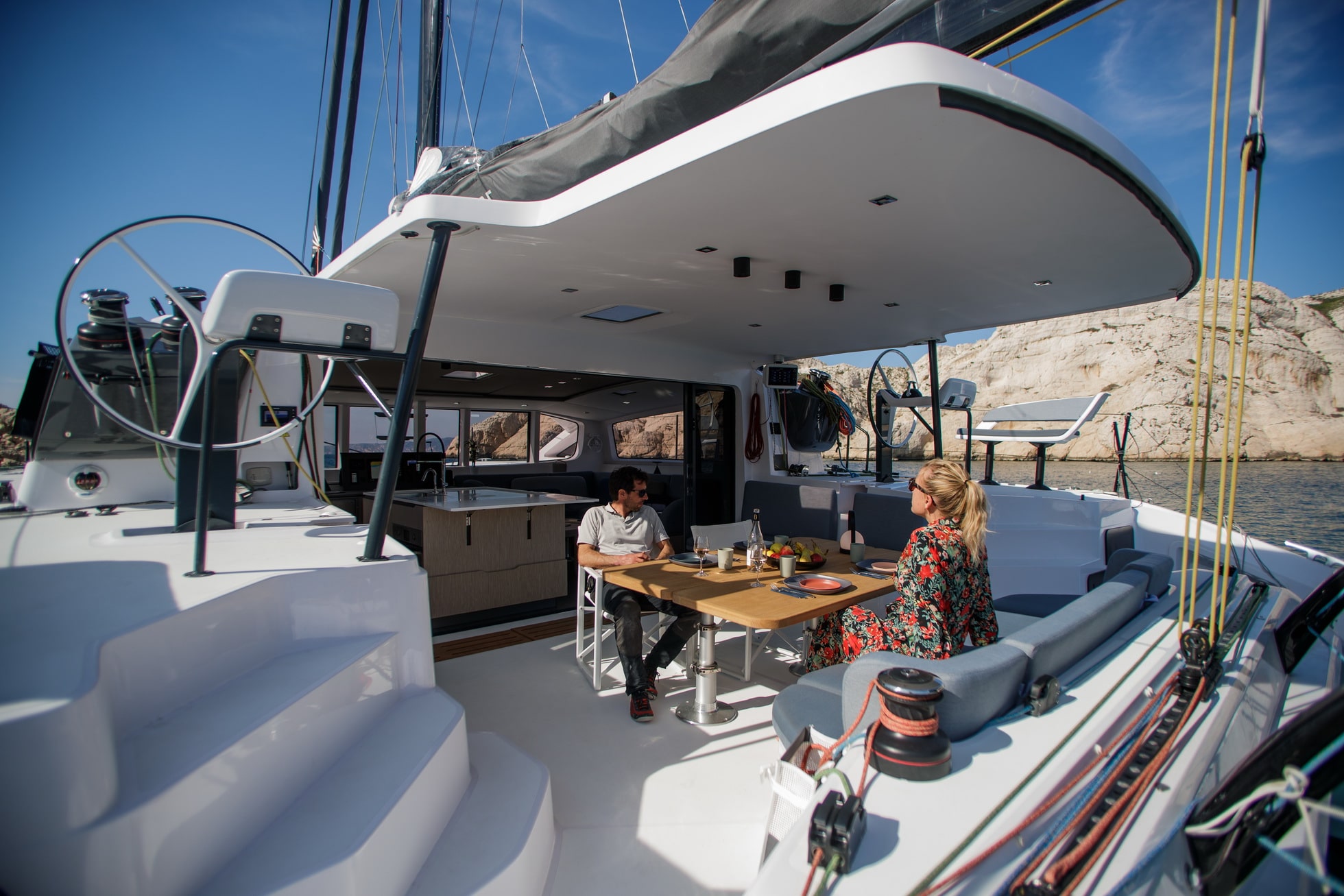
First: life in the tropics. Unless in a multi-storey superyacht with air-con, life on a monohull in hot weather revolves around the cockpit. People enjoy taking advantage of the glorious view and refreshing breeze, whilst avoiding the stuffy galley, dark saloon and sweaty people down below. On a multihull this is entirely the opposite. The open plan living style means that you are all in it together in the fresh air – cooks in the galley, navigators at the chart table, children playing on the nets, dinner guests sipping cocktails and even snorkelers on the swim platforms. NB Not good when chopping onions. This is much unlike a monohull where daily life is split above and below decks. It’s common for a few people to be pulled away from a good conversation at dinner time, or a sailing manoeuvre, to the seclusion of galley cooking, which can really break the flow of the evening. At sea, the loss of horizon can have more than social implications, possibly resulting in a rapid onset of seasickness.
Our November Atlantic crossing in 2019 was far from tropical – I can confirm that on an Outremer 45, the heart of the home does not move with colder weather. As the cold seawater chilled the hulls whilst the warm air rose, the saloon became the warmest zone. Therefore, all of us – cooks, sailors, baby and passengers – could still spend time together– Elayna playing with Lenny, Riley checking the weather, Greta stirring the soup, Svante and myself chatting about life at home. It was easy to multi-task too; the large windows and high aspect view-point meant we could all keep a look out even when we were off watch. Fiery sunsets, a dry sunrise (despite the rain at daybreak), squalls, whale spouts, mammoth 20-foot waves – you can see it all from the comfort of your pyjamas. A monohull in the winter is wonderfully cosy too. My memories of drinking hot chocolate, playing cards with friends, all snuggled up together on the tiny saloon couch will stay in my heart forever. They are precious memories, but I couldn’t tell you anything about the weather or what the skipper was doing.
“They’re perfect for a dinner party, but you just don’t get the same feeling sailing do you?” said Nigel, as we had that age old mono vs multi debate. Nigel is a die hard monohull sailor. Now just over 60, he has owned six boats since the age of 25 – all monohulls – and I don’t think will ever be converted – but I played devils’ advocate all the same.
“You’d be surprised I think,” I replied. “Even upwind, whilst it wouldn’t rival a well-trimmed performance monohull, it certainly would beat any mass production cruising monohull with angles and speed. Plus if you are looking at VMG, then there is no comparison.” I’ll leave the experienced Outremer sailors to talk specific numbers, but the speed and angle conversation normally surprises monohull sailors. Catamarans are famous for being pigs upwind. I’d say that Outremers and other performance catamarans with narrow hulls, and lightweight stiff structures undermine that assumption.
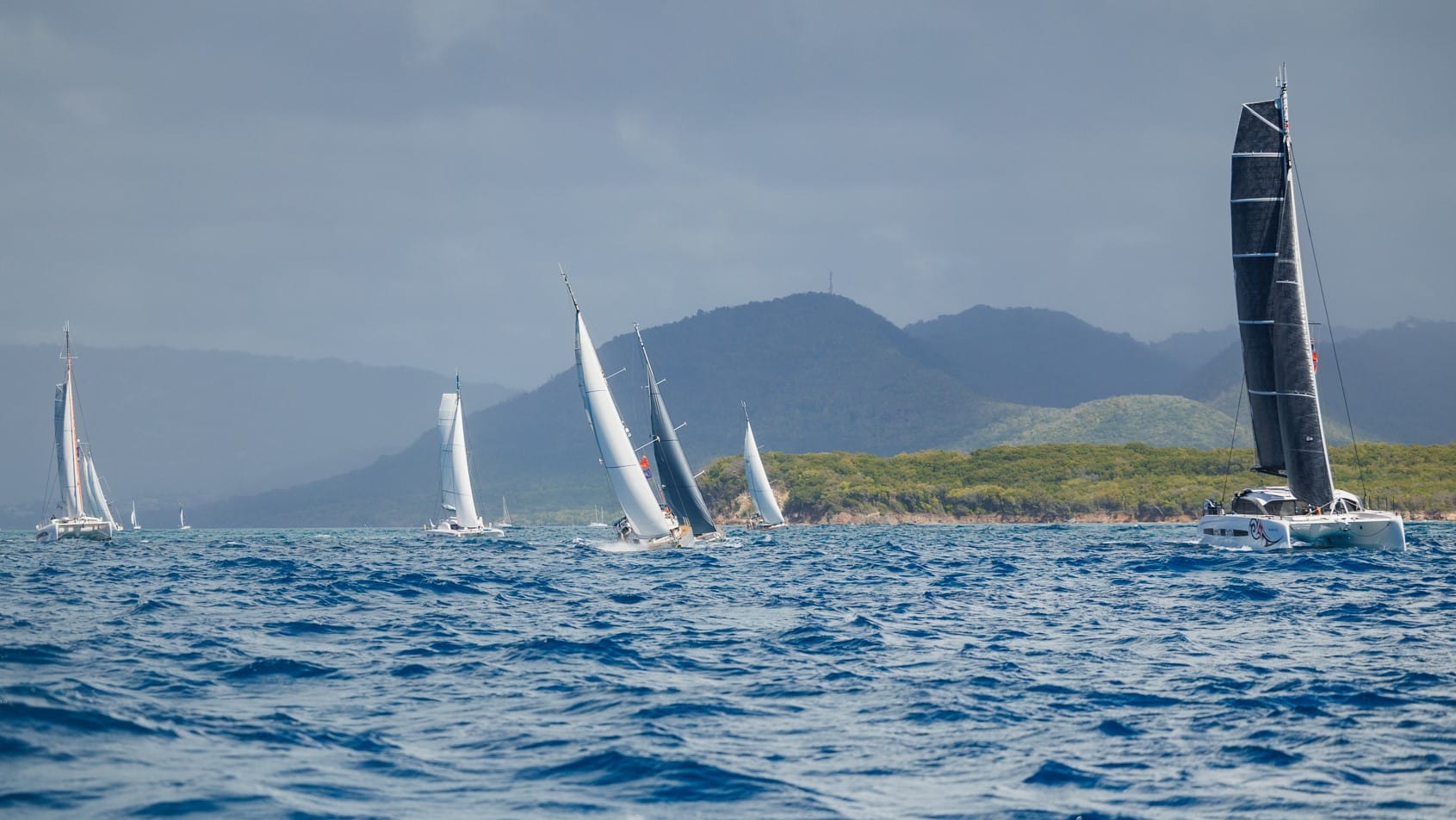
I continued, “To be honest, I wouldn’t buy a catamaran for upwind sailing. I’d buy it for the downwind stuff. To achieve equivalent downwind speeds on a monohull – surfing at 20 or 25 knots regularly – I feel the skill level required, the sail area needed, and the technical specifications would be so much higher. Speed feels less accessible on a monohull.”
The transition from sailing a monohull to sailing a multihull is not particularly steep. However, it is important to respect the potential power that a multi-hull like a catamaran can harness. I would recommend hiring an experienced multihull sailor for a week or so on the first voyage to steer you in the right direction. My first crossing on a multi-hull was on La Vagabonde, and it was certainly a dive into the deep end. So, this is a “do as I say, not as I do” type blog. I hope you can take this as confidence that it is not an unachievable jump for any monohull sailor, but heed caution too.
The main difference between one hull and two is that the boat becomes less communicative. For example, you do not have the obvious signs that you are overpowered like the submersed toe rail, or the yacht uncontrollably rounding up into the wind on a catamaran. Sailing with too much cloth up can be a safety issue and is why I would recommend getting some ‘translation’ help at first. In time, you will learn to focus on different things: the windspeed, the leeway, the fore-aft slant (is the bow diving?) and build a more finessed connection with the aggression with which the boat is accelerating forwards. This is all less intimidating than it sounds. It’s arguably a slower learning curve and requires some patience, but the upside is that you stay remarkably drier during the learning process and return to the dock with considerably less bruises!
Nigel considered the response and then replied with a typical answer in a conversation like this.
“I suppose you are probably right. But you just can’t beat that feeling of the boat heeling, and the hull humming, and everything just cutting through the water so beautifully as you can on a monohull.”
The conversation of monohull v.s. multihull is often discussed between sailors. But few sailors have actually sailed extensively on both a monohull and a multihull. Certainly not at similar times in their life where they require similar characteristics from their vessel. This last point is the key to the decision on whether to buy a monohull or a multihull – in the same way you decide what house to buy – what do you need it for?
Like Nigel, if I was to buy a boat alone or with my partner, I would be inclined to buy a monohull because I have grown up a monohull sailor. The experience of heeling over, the connection I feel due to that lean, the curvature of the hull and how it affects the movement of the boat, the slip of the keel and the break of the waves on my skin – these are things that I connect on a subconscious level with good sailing. This is my happy place.
However, if I were planning to live on a yacht for several years and sail around the world with small children, or elderly relatives, or invite lots of non-sailing friends on for relaxed cruising trips I would seriously consider a multihull. This consideration would strengthen if I had a freedom to choose my schedule to align with prevailing winds and flatter seas. The option to average 11 or 12 knots a day and avoid a big storm, whilst living in a relatively stable boat and still home schooling my children would be the safer option. It would also be better for morale considering the company. The reduced swing in an anchorage, ample sunbathing space on the nets, and not one but two swim platforms definitely makes for a better ‘holiday’ experience. If I could afford it, I could always strap a one or two man dinghy to davits to get my heeling-feeling kicks!
To conclude, for anyone considering the jump from a monohull to a multihull my closing advice or thoughts would be the same as buying clothes, or decorating a house, or taking up a new hobby – don’t knock it till you’ve tried it. It might just surprise you.
Continue navigation
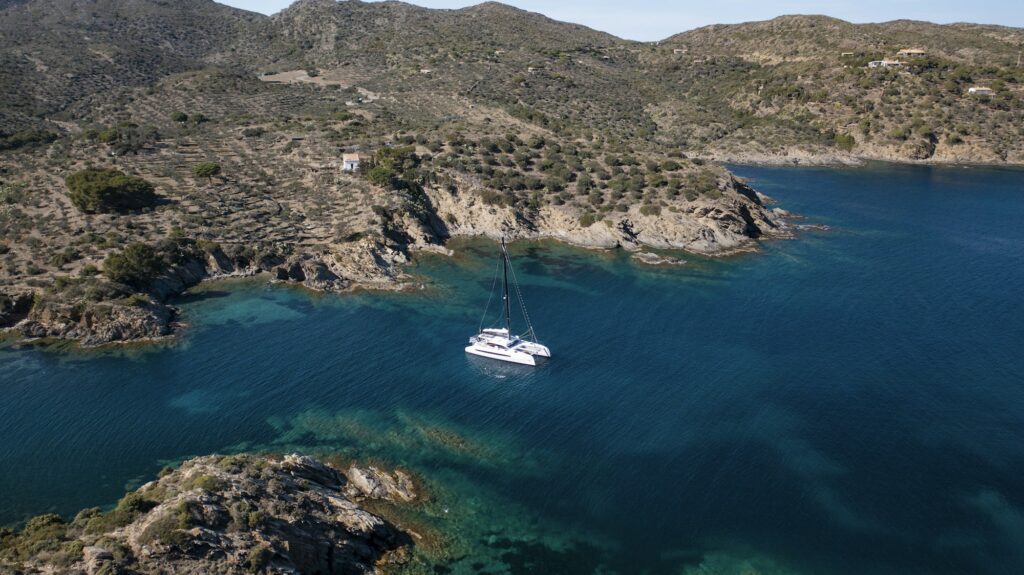
Why sail around the world in a catamaran rather than a monohull?
Sailing around the world is a dream come true: you discover the world to the rhythm of the wind and the stopovers, exploring new destinations every day as you sail. If you’re just starting to read this article, you’re probably nurturing this project. Are you planning to sail around the globe? Then the choice of ship for your next voyage is crucial.
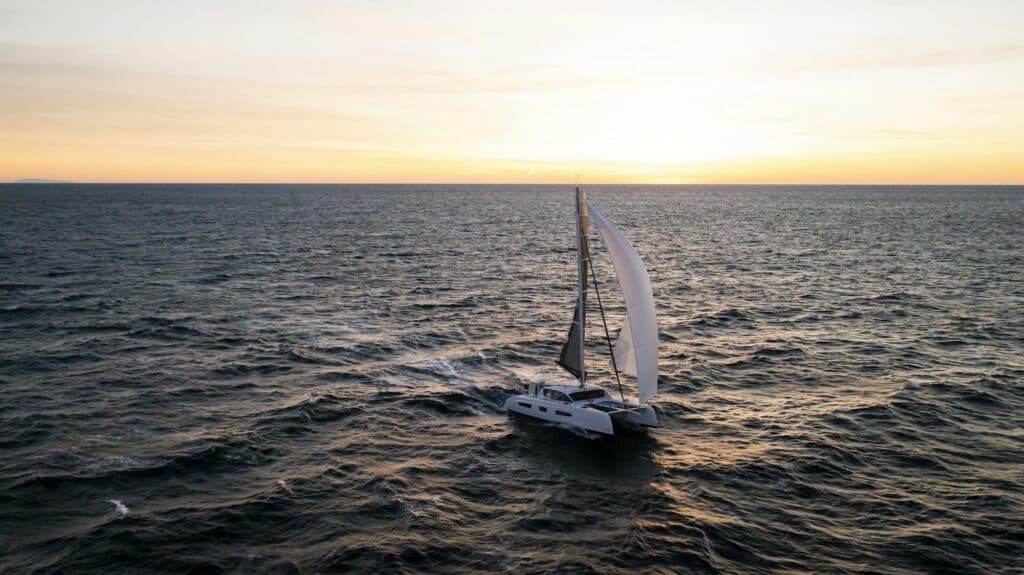
The Importance of Defining Success
In the Autumn of 2023, I ran a ‘Webinars for Women’ mini-series on transatlantic preparations. The first session was titled: “How to approach transatlantic preparation.” As I zoomed out of the nitty gritty of canned food recipes, spare parts inventories, and preventative sail repair and took a broader look at the framework for a successful crossing, I homed in on what I think the first and most important step is: defining your goal.

Sailing in the Bahamas : unforgettable stopovers
The Bahamas Islands are a dream destination to explore under sail! In the heart of the Caribbean Sea, the archipelago offers the chance to enjoy sailing through splendid scenery, pleasant places to stop off and memorable activities. In this article, the Outremer team tells you what they consider to be the essential stages of a catamaran cruise in the Bahamas.
- Course Checklist
- Important Information
- How To Get To Us
- Our Instructors
Monohull vs Catamaran: A Deep Dive into Design and Performance
The genesis of two designs.
In the world of sailing, the debate between monohulls and catamarans is a tale as old as time. The history of these two iconic designs stretches back to antiquity, reflecting the evolution of human innovation and our insatiable desire for exploration.
The monohull's genesis lies in the early days of human seafaring. Traditional cultures from the Mediterranean to the South Pacific have all used some form of monohull craft for fishing, trade, and exploration. The monohull's sleek, single-hulled design, characterized by a deep keel and distinct bow and stern, offers an efficient shape for cutting through waves. Over centuries, the monohull design has been refined and perfected, culminating in the magnificent yachts we see gracing our waters today.

On the other hand, the catamaran, a vessel with two parallel hulls, boasts a legacy equally steeped in seafaring history. Its origins can be traced back to the outrigger canoes used by ancient Austronesian cultures.
The word 'catamaran' itself is derived from the Tamil word 'kattumaram', which loosely translates to 'logs tied together'.
These innovative sailors discovered that by adding a second hull, they could greatly improve the stability and speed of their vessels, a design principle that holds true to this day.
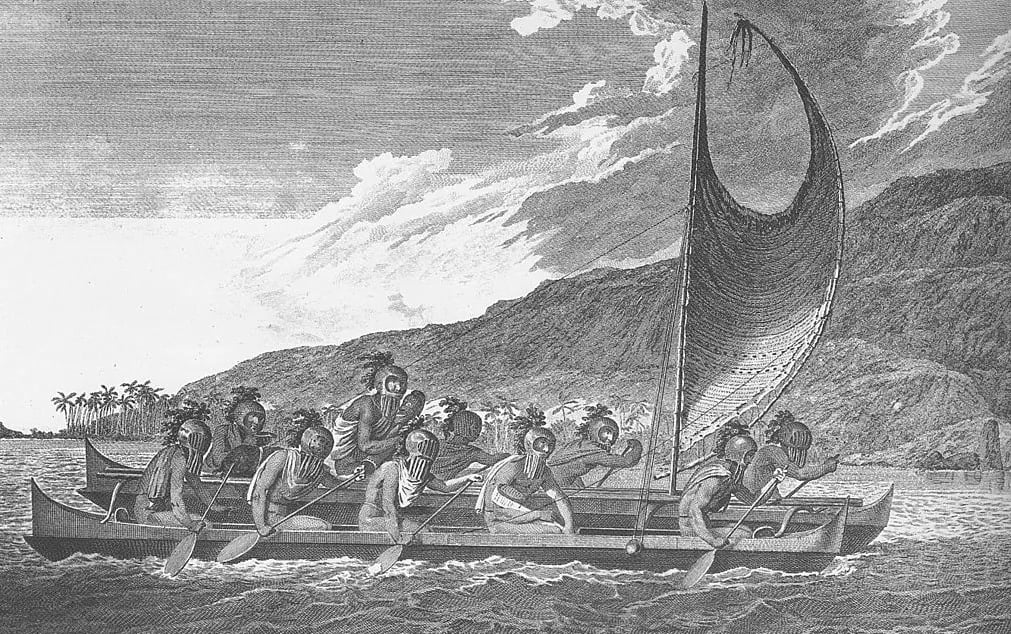
Exploring the Monohull Design
Stepping into the present, let's delve deeper into the modern monohull design. Its traditional single hull offers a quintessential sailing experience that's hard to match. Monohulls are typically seen as the embodiment of the romantic sailing ideal, thanks to their elegance and the graceful way they heel under sail.
One of the major benefits of monohulls lies in their seaworthiness. Their deep keels provide excellent stability, allowing them to handle heavy seas and high winds effectively. In addition, the keel acts as a counterbalance, enabling the boat to right itself after being heeled over by a gust of wind. This 'self-righting' characteristic is a significant safety feature exclusive to monohulls, adding a level of reassurance when navigating challenging sea conditions.
Monohulls are also known for their responsive handling and satisfying sailing performance. The mono-hulled design cuts cleanly through waves, resulting in a smooth and predictable ride. If you're the type of sailor who enjoys feeling the wind and waves' raw power, the visceral connection that a monohull provides is unparalleled.
However, as with everything in life, monohulls also have their downsides. For one, space can be at a premium. The deep keel and the rounded hull shape necessary for stability and performance take up much of the interior volume, leaving less room for living space compared to a similarly sized catamaran.
Another consideration is the heeling motion. While some sailors love the feeling of a boat leaning into the wind, others may find it uncomfortable or disorienting, especially during prolonged passages.
Despite these trade-offs, monohulls continue to hold their charm for many, offering a blend of tradition, performance, and adventure that has stood the test of time. In the next part of this deep dive, we'll shift our focus to the twin-hulled wonder of the sailing world: the catamaran.
The Catamaran Conundrum
As we switch gears to catamarans, it becomes apparent how contrasting they are to their monohull counterparts. Catamarans, with their dual hulls connected by a central platform or cabin, present an entirely different set of strengths and challenges.
Let's start with one of the most prominent features of catamarans: their stability. The wide beam of a catamaran provides a significant increase in stability over a monohull, reducing the boat's tendency to roll. This stability not only enhances the comfort of your crew but also allows for safer and easier movement on deck and below. If the notion of preparing a meal in a level galley while underway appeals to you, a catamaran might be the perfect fit.
Space is another major advantage of catamarans. With essentially two hulls worth of volume, catamarans typically offer much more living space than a similarly sized monohull. This makes them an attractive option for those planning extended cruises or living aboard. The additional space also allows for separate, private cabins in each hull, perfect for accommodating families or groups.
When it comes to performance, catamarans have a distinct edge in certain areas. Their dual-hulled design and lack of a ballasted keel result in less drag, allowing them to often outpace monohulls in moderate conditions. However, this speed advantage may be offset in heavy weather, where the ability to cut through waves (rather than ride over them) can make a monohull's ride smoother and faster.
But, just like monohulls, catamarans aren't without their drawbacks. While their stability and flat sailing characteristics are often seen as benefits, they can also create a false sense of security, leading some sailors to push their boats beyond safe limits. Additionally, while catamarans are significantly harder to capsize than monohulls, if they do flip, they generally won't self-right like a monohull would.
Furthermore, catamarans can be more challenging to handle in confined spaces due to their wider beam. Docking, in particular, can be trickier, especially in marinas designed with narrower monohulls in mind. Also, the increased beam and dual hulls often lead to higher mooring and maintenance costs.
Monohull vs Catamaran: Performance Parameters
Before we take this deep dive to its conclusion, it's important to touch on a few key performance parameters. These can greatly influence whether a monohull or catamaran would be a better fit for your sailing needs.
For starters, how a boat handles various wind conditions is critical. Monohulls, due to their keeled design, tend to excel upwind. Their ability to 'point' into the wind is usually superior to that of a catamaran. On the other hand, catamarans, with their lighter weight and reduced drag, often have the upper hand in downwind and lighter wind conditions.
Another factor to consider is load carrying capacity. While catamarans have more space for storing gear and provisions, they can be more sensitive to overloading. Additional weight can significantly impact a catamaran's performance, whereas monohulls tend to be more forgiving in this regard.
In the final part of this blog, we'll wrap up our deep dive by considering these and other factors to help determine which design might be the best fit for your sailing needs.
Choosing Your Vessel: What Suits Your Sailing Style?
Now that we’ve explored the design principles and performance traits of monohulls and catamarans, it’s time to consider what kind of vessel will best cater to your personal sailing needs and preferences.
If your sailing plans involve long passages in open waters, especially in rougher seas or challenging wind conditions, a monohull's sturdy and seaworthy design might be the most fitting choice. Their excellent upwind performance and smoother ride in heavy weather will provide you with both comfort and safety on lengthy oceanic voyages.

For those attracted to the exhilaration of speed, catamarans, with their swift downwind capabilities, can offer a thrilling sailing experience. They can be the ideal choice if your sailing adventures are primarily focused on coastal cruising, island-hopping, or participating in sailing races where their speed advantage can shine.
Lifestyle preferences play an essential role as well. If you value space and comfort, and perhaps are contemplating living aboard or planning extended family cruises, the spacious interior of a catamaran, with its level sailing and private cabins, may be the superior option.
However, if you're a sailing purist who enjoys the classic feel of a boat that heels under sail, the thrill of mastering the art of balancing a boat in various wind conditions, a monohull will likely provide the sailing experience you're seeking.
As for cost considerations, remember that while catamarans offer more living space and stability, they can also come with higher purchase, maintenance, and mooring costs.
Closing Thoughts: Your Ideal Adventure on the Water
If you're looking to buy or charter a sailboat , the choice between a monohull and a catamaran ultimately boils down to your sailing goals, personal preferences, and budget. There's no definitive answer to which is better because it's subjective to the individual sailor.
Whether you're lured by the traditional appeal and seaworthiness of a monohull or the comfort, stability, and speed of a catamaran, the most important thing is to choose a vessel that will provide you with many memorable and safe adventures on the water.
At Sailing Virgins , we love them both and appreciate their unique characteristics. Whatever you choose, the sea will always be an ever-changing playground that continually challenges and rewards those who embrace the sailing lifestyle.
If you're still unsure about which one is for you, why not join one of our sailing courses or adventures? It's the perfect way to gain hands-on experience and discover what type of sailing brings you the most joy. Feel free to press the button below to check out our courses.
Fair winds and following seas to all prospective boat buyers out there!

Related posts
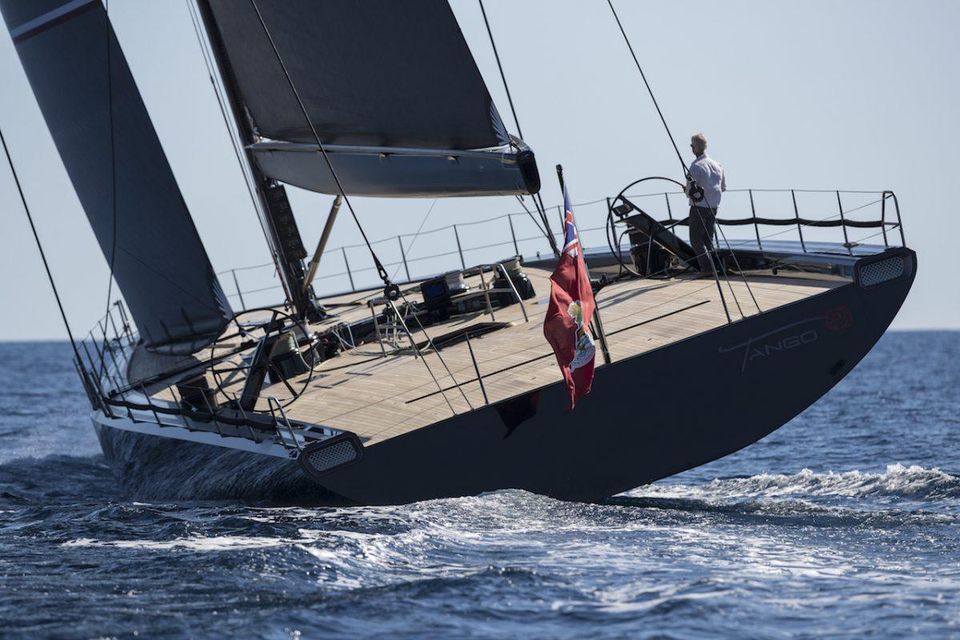
Catamarans vs. Monohulls
Which is better, a monohull or a catamaran.
This question gets asked a lot in sailing. Especially...
Recent Posts
- August 2016 (11)
- May 2023 (11)
- April 2023 (10)
- September 2016 (8)
- November 2016 (5)
- June 2016 (3)
- July 2017 (3)
- March 2018 (3)
- November 2018 (3)
- June 2019 (3)
- June 2023 (3)
- October 2016 (2)
- January 2017 (2)
- February 2017 (2)
- May 2017 (2)
- August 2017 (2)
- October 2017 (2)
- February 2018 (2)
- December 2018 (2)
- June 2022 (2)
- July 2022 (2)
- November 2015 (1)
- April 2016 (1)
- May 2016 (1)
- December 2016 (1)
- April 2017 (1)
- September 2017 (1)
- November 2017 (1)
- December 2017 (1)
- January 2018 (1)
- April 2018 (1)
- July 2018 (1)
- September 2018 (1)
- January 2019 (1)
- July 2019 (1)
- September 2019 (1)
- January 2020 (1)
- March 2020 (1)
- April 2020 (1)
- May 2020 (1)
- June 2020 (1)
- April 2021 (1)
- August 2022 (1)
- October 2022 (1)
- December 2022 (1)
- July 2023 (1)
- August 2023 (1)
- January 2024 (1)
- how to (21)
- sailing (14)
- Sailing Tips (12)
- corporate (9)
- sailing course (7)
- General (6)
- Insider (6)
- professional development (6)
- vacation (6)
- Mindfulness (5)
- leadership (5)
- Performance (4)
- group travel (4)
- opinion (4)
- opinions (4)
- qualifications (4)
- Interview (3)
- Trip Notes (3)
- Uncategorized (3)
- adventure (3)
- sailing virgins (3)
- Instructor Course (2)
- Self-Care (2)
- catamarans vs monohulls (2)
- charter boat (2)
- island adventure (2)
- networking (2)
- preparation (2)
- sailing guide (2)
- youtube (2)
- Athlete (1)
- Beginner (1)
- City Guides (1)
- Failure (1)
- First Time (1)
- Maderia (1)
- check out (1)
- fishing (1)
- french polynesia (1)
- gear tips (1)
- golf vs sailing (1)
- safety brief yacht (1)
- the yacht week (1)
- trip review (1)
The founders of Sailing Virgins started things as a result of having some incredible sailing seasons in the Mediterranean and Caribbean working for sailing company The Yacht Week. James then worked for and for a while managed Tortola Sailing School. In 2016 he branched off and started Sailing Virgins. We LOVE how sailing is changing. Top speeds in the America’s Cup were thirteen knots not so long ago. Now they’re 45 knots. If you’re excited by that, we’re with you. Giddy up!
- Wickhams Cay 2 Road Town, Tortola VG1110, British Virgin Islands
- +1 (272) 999-1920
- [email protected]
© LOVE SAILING VIRGINS 2016-2024
- Terms & Conditions
- Privacy Policy

- Boats , Marine Engineering
What is a Catamaran? Catamaran Boats Vs Monohull Vs Trimaran
Olivia benjamin.
- July 2, 2023
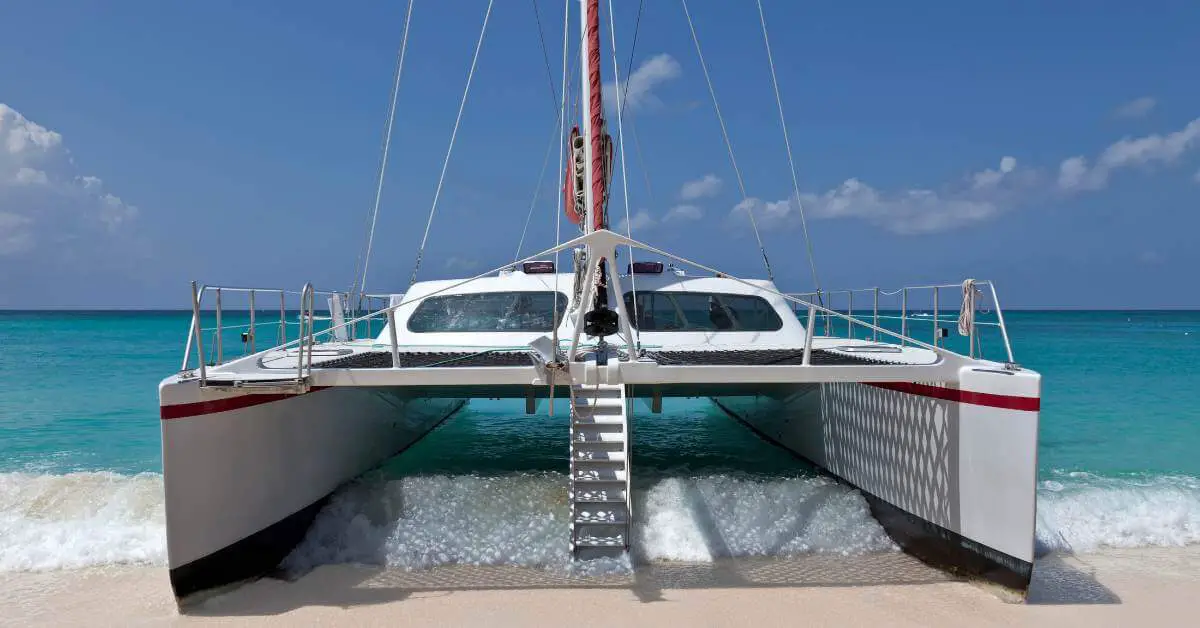
Diving into the world of catamarans, those magnificent vessels revolutionized the boating industry with their stability, speed, and remarkable spaciousness. The secret to their superiority? It’s all in the design, with two sleek hulls, side by side, linked by a bridge deck. That’s the design secret that set them apart from traditional single-hulled vessels.
Catamarans have become the first-choice vessel for sailors, cruising fans, and yacht chartering enthusiasts with their exceptional stability, unparalleled comfort, and outstanding performance, even under challenging weather conditions.
So, get ready to reveal the charm and brilliance of these awesome watercraft.
What is a Catamaran?
A catamaran is a type of yacht or boat characterized by its unique design featuring two parallel hulls connected by a bridge deck. This twin-hulled structure sets catamarans apart from traditional monohull boats and offers a range of advantages that have made them increasingly popular in the boating world.
Stability sits at the top of a catamaran’s list of advantages. The two hulls offer a broad base, significantly enhancing stability even in rough waters.
In addition to stability, catamarans hold a reputation for their spaciousness; a feature monohull boats find hard to match. A catamaran offers an inviting living space above and below the deck thanks to the wide spacing between the dual-hull structure.
Catamarans come in various sizes, from compact versions perfect for a day’s sail to larger variants designed for extended cruising or fishing. This versatility enables each boater to find a catamaran that fits their specific needs and desires.
Catamaran vs. Monohull
In the world of boats, the choice between a catamaran and a monohull is pivotal. Both boats offer unique advantages and face their challenges. Being aware of these differences can guide you in making a well-informed decision. Let’s explore some of these differences:
Sailing Performance
Thanks to their dual-hulled design, catamarans are known for their speed and stability. This configuration enables them to move through the water with minimal resistance, resulting in higher average speeds.
Conversely, Monohulls have one hull to navigate through the water, which may result in a marginally slower sailing experience.
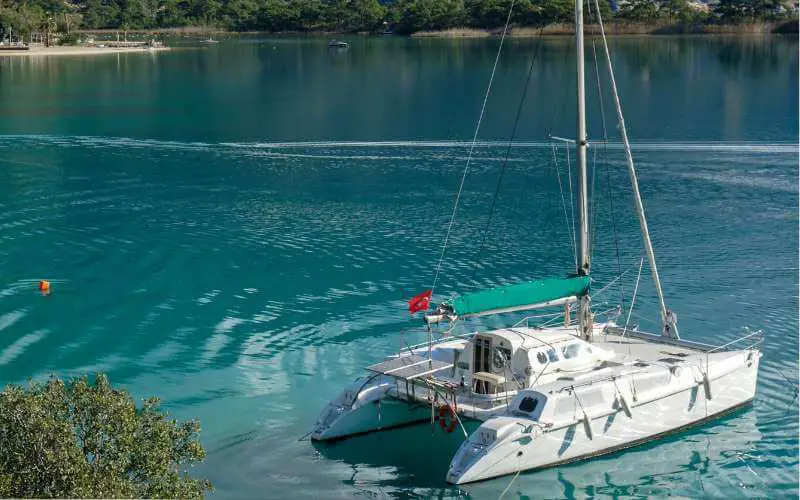
Maneuverability
Catamarans gain the upper hand in shallow waters with their twin hulls. The twin hulls allow it to have a shallower draft, meaning that it can sail in waters that are too shallow for monohulls.
This grants catamaran owners access to exploring remote coves and anchoring in secluded bays, mostly inaccessible to monohulls.
Catamarans are appreciated for their tight turning circles and easing handling in marinas and tight spaces. However, monohulls boast superior maneuverability under sail due to their single-keel design.
Catamarans offer ample space due to their wide beam. The dual hulls facilitate generous living space on the deck and below, providing room for multiple cabins, saloons, and well-equipped kitchens.
In contrast, monohulls offer a traditional sailing experience with their characteristic lean and heel, which some sailing purists prefer.
Catamarans, especially larger ones, are often costlier than monohulls. This is due to the increased materials and labor required to build a catamaran’s twin hulls. Furthermore, the larger sail area and rigging of catamarans can lead to increased maintenance costs.
However, catamarans typically have higher resale values due to their popularity and demand in the market.
Catamaran Vs Trimaran
For sailing enthusiasts ready to explore the open waters, multiple choices for the type of boat with varied options. Among these, catamarans and trimarans are two popular choices that offer distinct features and benefits.
Both catamarans and trimarans are designed with multiple hulls. These boats have unique features catering to different sailing preferences and conditions.
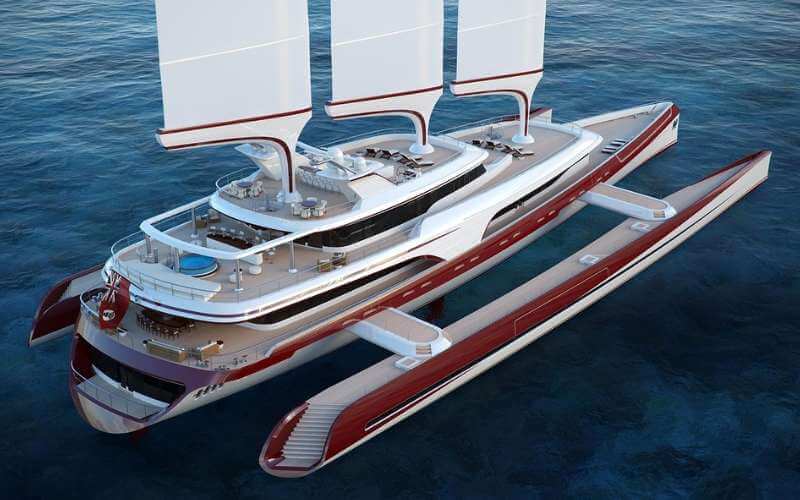
Let’s explore some of differentiating factors between these two unique vessels:
Number of Hulls, Performance & Stability
As its name implies, a catamaran features two parallel hulls, while a trimaran three hulls. The hull count influences the boat’s stability, maneuverability, and overall performance on the water.
Catamarans are widely recognized for their exceptional stability and sailing performance. The twin-hulled design provides a large and stable platform on the water. With a wide beam and low center of gravity of a catamaran make it less likely to tip or heel dramatically during sailing, contributing to an overall sense of safety and stability onboard.
In contrast, trimarans, with their three hulls, offer a unique combination of stability and speed. The central hull, or the “ ama ,” is typically larger, offering buoyancy and stability. Two smaller hulls, known as the outriggers or “ amas ,” further contribute to stability and help counterbalance the forces acting on the boat. This tri-hulled design allows trimarans to sail at high speeds while maintaining stability.
While both catamarans and trimarans offer exceptional stability, catamarans generally have a wider beam. The twin-hulled catamaran design provides ample living space above and below the deck. Nonetheless, the narrower beam of trimarans may restrict the space available for living and other features. However, trimarans are still ideal for those prioritizing performance and exhilaration on the water.
With their dual hulls, catamarans have a distinct edge in shallow waters and constrained spaces. Their design provides a shallower draft, opening up exploration opportunities in shallow anchorages and exploring areas inaccessible to monohulls or even trimarans.
The twin-hulled design enables catamarans to efficiently deliver tight turning circles, making them highly maneuverable in marinas and crowded harbors.
Despite showcasing excellent maneuverability, Trimarans may experience comparatively deeper drafts due to the additional hull, potentially restricting their access to certain shallower areas.
Sailing Experience
Due to their wide beam and sturdy build, catamarans generally experience minimal heeling or leaning while sailing.
In contrast, trimarans might experience slight leaning during sailing, giving sailors a more traditional sailing experience that may be attractive to some sailors.
Assessing the cost between catamarans and trimarans can be complex. The final price tag usually depends on factors such as design intricacies, construction complexity, and the equipped amenities on the boat.
With their multi-hulled design, both catamaran and trimaran often demand more materials and craftsmanship, which can escalate the total cost. These boats typically have larger sails and rigging, increasing maintenance expenses.
Nonetheless, the cost will hinge significantly on the quality and sophistication of the design and equipment involved; hence, categorically declaring a cheaper option may be challenging.

Types of Catamarans (Sailing Catamarans Vs. Power Catamarans)
Catamarans are available in various shapes and sizes, catering to boating requirements and preferences. Sailing and power catamarans are the main types, each having distinct features and advantages.
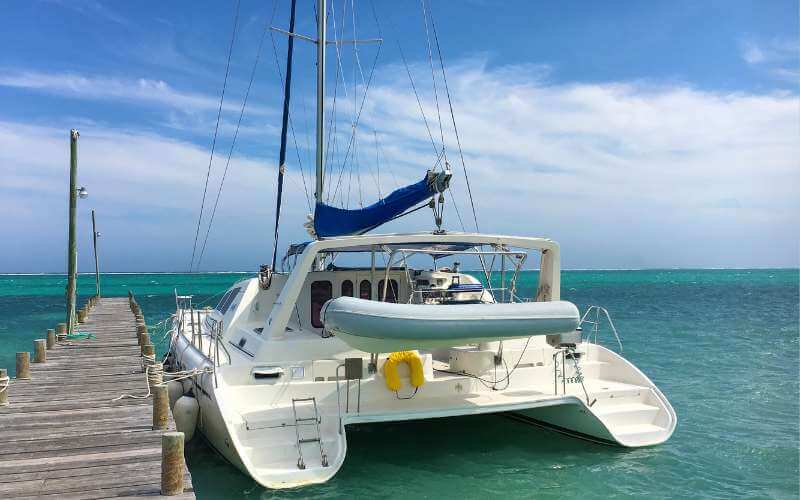
Sailing Catamarans
Sailing Catamarans are designed with the thrill of cruising the sea under wind power. They offer excellent stability, a desirable trait for those seeking a smooth experience even in rough waters. The wide beam minimizes seasickness risks and lends itself well to overnight cruises.
Regarding propulsion systems, Sailing Catamarans use wind force captured by sails for movement. This natural, renewable energy source offers an eco-friendly and tranquil boating experience.
However, modern sailing catamarans also have auxiliary engines that assist during calm winds or intricate maneuvering in harbors.
Power Catamarans
Power catamarans are designed for those who prioritize speed and efficiency. These particular catamarans are equipped with powerful engines that facilitate them to reach high speeds effortlessly.
While the fundamental design of Power Catamarans mirrors that of Sailing Catamarans – the wide beam with dual hulls – the power source differs dramatically. The twin-engine setup (one per hull) allows for higher cruising speeds and improved maneuverability.
Power catamarans are known for their superior fuel efficiency, an essential consideration for day-long expeditions. Despite prioritizing speed, they don’t sacrifice comfort; the power catamaran’s design boasts spacious interiors similar to Sailing Catamarans.
Advantages of Catamaran Boats
Catamaran boats offer numerous benefits, making them an attractive option for experienced sailors and those new to boating.
1. Stability : Catamarans offer increased stability over monohull boats due to their wider base and even weight distribution. This stability is noticeable during sailing, anchoring, and even when exploring shallow waters, providing a more comfortable experience for passengers.
2. Shallow Draft : Catamarans can easily navigate in shallow waters due to their low draft. This feature allows for exploring narrow coastal areas, coves, and bays that may be inaccessible to larger monohull boats.
3. Comfort and Space : The parallel hulls of a catamaran create more living space. This includes a spacious kitchen or galley, comfortable sleeping quarters, generous storage space, and a large multipurpose deck area.
4. Power and Speed : Catamarans are known for their speed and performance. Their twin-hull design reduces wind and water resistance, allowing for increased speed. Their shallow draft also allows faster navigation in shallow waters or narrow paths.
5. Fuel Efficiency : Catamaran’s design contributes to their fuel efficiency. The wider base reduces drag, while its stability allows for constant sailing without extensive adjustments, leading to less fuel consumption.
6. Redundant Equipment: With duplicate systems and backup options for essential systems such as engines, steering, and electrical systems, ensuring uninterrupted functionality and safety even in the event of a failure or mechanical issue.
Drawbacks of Catamarans
While catamarans have unique design advantages making them popular, they also present certain limitations.
1. Responsiveness : Catamarans have less responsiveness due to their wider beam and twin hulls. This means they require more effort and time to turn, particularly in tight spaces or crowded marinas.
2. Pounding in rough seas : Catamarans may experience a pounding sensation when encountering large waves, causing discomfort and potentially increasing damage risk.
3. Wider beam challenges : The wider beam of catamarans can make finding suitable docking spaces difficult in crowded marinas or tight anchorages. Navigating through narrow channels or under bridges can also prove challenging.
4. Fuel efficiency at high speed : In strong headwinds or rough seas, the reduced drag of a catamaran increases speed but requires more fuel to maintain the higher speed.
5. Higher purchase and maintenance price : Catamarans often have higher purchase prices. The double hulls and equipment lead to increased maintenance costs and potential failures. Also, catamarans often require wider slips or specific berthing arrangements, resulting in potentially higher costs.
6. Sailing Performance : Due to their wider beam, Catamarans struggle to sail close to the wind. Their larger wetted surface area can create more drag when sailing upwind, impacting their performance in stronger wind conditions.
It is important for potential catamaran owners and operators to carefully consider these factors and choose a vessel that aligns with their specific needs and intended usage.
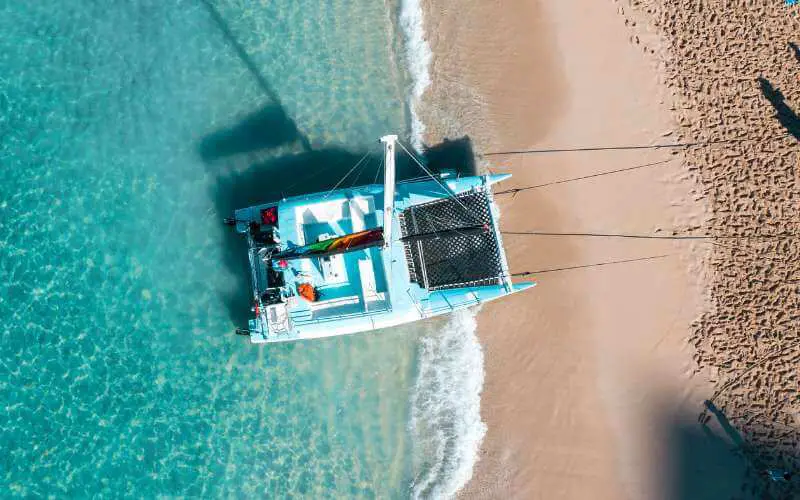
Tips for Sailing a Catamaran
Sailing a catamaran is an exciting experience but demands unique handling skills & knowledge. For a smooth sailing adventure with a catamaran, keep in mind the following tips:
1. Know Your Catamaran’s Design : Familiarize yourself with the boat’s layout, controls, sails adjustment, handling the rigging, and engine operation before setting sail. If necessary, understand how to operate the engines to ensure a safe journey.
2. Monitor Weather Conditions : Always check the weather forecast before departure. Remember, a catamaran’s wide beam makes it susceptible to strong wind gusts, so adjust your sails and course accordingly to maintain control.
3. Practice Maneuvering : Operating a catamaran requires skill and caution, particularly in tight spaces like marinas or crowded harbors. Practice maneuvering skills in open waters before docking or anchoring in challenging areas. Know how to use the engines efficiently for forward, backward, and sideways movements, keeping the boat’s draft in mind to avoid grounding or hitting reefs that could harm the hulls.
4. Know Your Depths : One of the major considerations when sailing catamarans is their draft – the minimum depth of water a boat sinks to when loaded. Being aware of the draft of your catamaran prevents you from running aground or damaging the hulls on underwater obstacles or shallow areas. Regularly use your depth finder, follow up-to-date nautical charts, and remember that conditions can change rapidly.
5. Harness the Wind : To maximize your sailing efficiency, understand and use the best sailing angles for your catamaran since this varies among different catamaran models. Learn how to trim your sails properly to harness wind power effectively and constantly watch for wind direction and speed changes to adjust accordingly.
6. Maintain Your Catamaran : Regular maintenance of your catamaran is crucial to ensure its optimal performance and longevity. Establish a routine check for potential issues, including regular hull inspections, rigging wear and tear, and engine checks if applicable. Cleaning the vessel regularly prevents algae build-up and exposes hidden potential issues that might otherwise be overlooked.
7. Plan Your Berthing: The increased beam size of a catamaran compared to monohull sailing yachts means you’ll need a wider space for berthing. Pre-planning your berthing locations can save you from avoidable berthing complications. Always approach the berth safely and slowly, and be mindful of surrounding boats and hazards.
8. Prioritize Safety : While the stability of catamarans can make them feel exceptionally safe, it’s important never to compromise on safety standards. Ensure everyone on board is familiar with basic safety protocols, knows how to use lifesaving equipment, and knows where it’s stored. Regular checks and upkeep of safety gear, including lifejackets, fire extinguishers, and flare kits, are essential.
Remember, these starting tips merely scratch the surface regarding sailing catamarans. Continuous learning and accruing experience on the water are crucial to becoming a skilled catamaran sailor.
Catamaran Boats FAQs
When it comes to catamarans, several questions are often circulating in the minds of novice and seasoned sailors. Let’s address some of these commonly asked questions:
What is the difference between a catamaran and a monohull boat?
The most significant differences between a catamaran and a monohull boat are their hull design. Catamarans feature two hulls connected by a bridge deck, while monohulls have a single hull.
Key advantages of catamarans include greater stability, spacious living areas, and a shallower draft. Conversely, monohulls are typically known for their traditional sailing experience and ability to slice through waves.
How does the cost of a catamaran compare to a monohull?
Catamarans are generally more expensive than monohull boats of similar size and features due to the increased materials, labor, and engineering necessary to build them.
Furthermore, catamarans might have higher maintenance and operating expenses due to their dual hulls and larger living spaces. However, it’s important to remember that catamarans provide more living space and stability for those who value comfort and spaciousness.
What is the typical draft of a catamaran?
A catamaran’s draft refers to the hull’s depth below the waterline. Catamarans are known for their shallow draft, which allows them to navigate in shallower waters compared to monohull boats.
The specific draft varies depending on a catamaran’s size and design but typically ranges from 2 to 5 feet. This shallow draft is advantageous in coastal areas, island hopping, or exploring shallow-water destinations.
Can catamarans be used for racing?
Yes, catamarans have become increasingly popular in the realm of sailing races. Racing catamarans are designed with lightweight materials and streamlined hulls that enable them to reach remarkable speeds.
They also feature advanced sail systems that boost performance, such as rotating masts and asymmetrical spinnakers. Catamaran racing is both exhilarating for participants and a fascinating spectacle for spectators.
Are catamarans suitable for long-distance cruising?
Catamarans are well-suited for long-distance cruising due to their stability, spacious living areas, and efficient sailing capabilities. With their wider beam and dual hulls, catamarans offer abundant living space above and below the deck.
This makes them comfortable for extended periods on the water, providing ample room for supplies, equipment, and socializing. Furthermore, the impressive stability of catamarans allows for a smoother ride, even in rough seas.
Boat Collisions: How to Avoid Collisions with Another Boat
Boating can be a fun and relaxing activity that many individuals enjoy. Whether cruising along the coastline, fishing with friends,
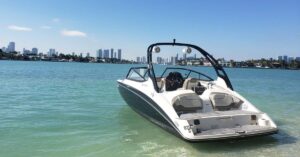
What is a Jet Boat? Propulsion System, Types, Pros and Cons
Jet boats are thrilling, high-speed watercraft making waves in the boating industry. Unlike conventional boats, a jet boat uses powerful
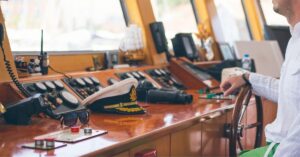
How to Steer a Boat: Mastering the Art of Boat Steering
If you’re ready to embark on a boating adventure and take hold of the helm, it’s time to dive into
Workshop Insider Newsletter
Be a workshop insider get our latest collection of news and announcements delivered to your inbox..., latest articles.
- September 12, 2023
The Ultimate Guide to Pipeliner Welding Hoods: Features, Benefits, Buying Guide, and Best Practices
- Welding Helmets Buying Guides
- September 11, 2023
- September 10, 2023
J-B Weld Removal: How to Remove JB Weld from Metal, Plastic, Skin, and More!
- Mechanical Engineering , Welding Technology
- August 19, 2023
- August 17, 2023
What are Bellows on a Boat: Everything You Need to Know
- August 16, 2023

- Privacy Policy
- Terms of Use
- Affiliate Disclosure
- Articles and Guides
Catamaran vs Monohull: The Great Sailboat Debate
16th jun 2023 by john burnham.

Do you love the natural sounds of water sliding past the boat’s hull and a breeze blowing across your rigging and sails while gliding ahead powered only by the force of the wind? If yes, you are well-suited to spending plenty of time on a sailboat, like so many generations of boat people before you.
But do you take your lead from the Egyptians who rigged sails on their boats built of reeds along the Nile River or follow the path of the Polynesians, who used an outrigger for extra stability and sailed from one Pacific island to the next in the earliest catamarans?
The question of which is better for sailing, one hull or two, has been a matter of debate over thousands of years. Today, let’s explore these two basic types of sailboat, and while we may not settle the argument once and for all, hopefully in the process you will begin to discover which option is better for you.
What Are the Differences Between Catamaran and Monohull Boats?
The monohull and the catamaran (often referred to as “cat”) are the two most common categories of sailboats, and of the two, the monohull far outnumbers the catamaran in popularity due to its simplicity and sturdiness. Advocates of the catamaran, however, are typically even more convinced than monohull sailors that their boats are best due to performance potential and overall spaciousness.
What are catamaran-style boats?
Catamarans are easily identified by their two-hull design. Two hulls sit side by side with an interconnecting deck or structural beams across the bap in the middle. Catamarans have been around since Pacific Islanders and other Austronesian people sailed them centuries ago, and they continue to gain popularity in a wide range of designs both as high-performance racing boats and ocean-cruising designs.
Although not part of this debate, a third sailboat type comparable to a catamaran is a trimaran. Trimaran sailboats are constructed similarly to catamarans but have three parallel hulls rather than two. Collectively, catamarans and trimarans are referred to as multihulls, and sailors of both types often refer lightheartedly to monohulls as “monomarans.”
What are monohull-style boats?
Monohull sailboats are the most common boat type because they feature a single hull, typically with a single mast and two sails. Rather than maintaining stability with a second hull creating a wider beam, monohull boats usually carry lead or other heavy ballast in their keel, or are stabilized by human weight as their crews lean out to counter the force of the wind. Monohulls can also be excellent racers and cruisers, depending on their size, volume, sail area, and displacement or weight.
Where Catamarans and Monohulls Excel
Each type of boat has its advantages, depending on what the owner wants in a boat. Here are the main advantages of each type.
Catamaran advantages
• More space . Catamarans have greater beam for a given length, which provides more space for the crew on a daysailer and larger living quarters on cruising designs, which are often laid out with berths in each hull and living quarters across the bridgedeck between hulls.
• Faster hull . If they are light enough, the sleeker shape and reduced wetted surface of two narrow, shallow hulls can produce quicker straight-line sailing speed than a single, deeper and wider hull.
• Comfort and stability . Two hulls provide better initial stability and generally heel less than monohulls, especially in light- or medium-strength winds and waves.
Monohull advantages
• Upwind sailing . When sailing against the wind, monohulls often sail at a closer angle to the wind and arrive more quickly at their destination.
• Easier motion . Heavier monohulls often have a slower, gentler motion in waves than a lighter catamaran.
• Load carrying capability . A monohull’s performance is reduced less than a catamaran’s when the boat is loaded heavily with cargo or crew.
• Righting characteristics . Larger monohulls have weighted keels that provide increased resistance to a capsize when the boat is heeled far over by wind or a wave and if capsized will return the boat to an upright position.

Catamaran vs. Monohull Sailing Speed
There are several reasons why a catamaran is often faster than a monohull boat. These include the fact that most catamaran hulls have less water resistance than monohulls, they are often lighter, and they can be more easily driven by a relatively small sailplan. At similar lengths, a catamaran can be dramatically faster than a monohull under similar sea conditions. However, weight is the enemy of a catamaran’s speed; a heavy or heavily loaded catamaran may be much slower than a lightweight monohull.
Catamaran vs. monohull power
A monohull under auxiliary power may be faster than a catamaran in certain conditions, like powering against a strong wind. In other wind and wave conditions, the catamaran is often faster. Also, with an engines on each hull, the cat is often much more maneuverable in close quarters or at the marina. While it may seem counter-intuitive, turning and controlling the boat is often less challenging than when sailing a monohull boat with the typical single engine. Monohull boats require more finesse when in tight quarters like berthing in a marina.
Catamaran vs. Monohull Efficiency
A sleek monohull may sail against the wind super efficiently, pointing close to the wind and making an excellent speed. However, the power-to-weight ratio of the catamaran allows it to make good use of whatever wind it has. Some fast, light catamarans can travel at speeds equal to or faster than the wind, something very few monohulls can achieve. When the wave action increases and you start sailing into the wind, the catamaran may lose its advantage, and in strong winds, the greater windage of the wide catamaran may have a pronounced slow-down effect compared to the sleeker monohull.
Catamaran vs. Monohull Stability
Despite not having a weighted keel, a catamaran design is able to avoid heeling over in strong winds or bad weather due to its greater width or beam. As a result, the multihull also tends to be more stable at anchor and any time in calmer seas. However, if the winds are strong and the waves are large, a monohull, with its keel weight and ability to sail against the wind while controlling the sails, is sometimes the steadier of the two types. While a monohull with weighted keel can be knocked down by strong gusts of wind, it will only capsize in extremely large waves. Likewise, a cruising catamaran can only capsize in large ocean waves, unless it is a fast, lightweight catamaran, that can more easily tip over in gusty winds and waves.
Catamaran vs. Monohull Safety
Power catamarans and power monohulls are relatively comparable in terms of safety. But depending on the size of the mast and sails, the weight of the boat, and the wind and wave conditions experienced, many sailors believe that a monohull configuration is safer than a catamaran for a sailboat. That’s mainly because while a monohull will initially heel over further in a strong gust of wind, the weight of its keel provides increasing stability as described above and if completely capsized, the keel typically helps the boat self rescue.
It should be clarified that many sailing catamaran designs are conservatively configured and difficult to capsize except in extreme ocean wave conditions—and the same can be said for larger power catamarans.
In terms of ultimate safety in the event of a capsize, however, the catamaran is considered safer because even should it turn once upside down, even if damaged, the catamaran with its two hulls and minimal ballast typically remains buoyant and provides a safer configuration in which to await rescue. By contrast, if a monohull’s hatches and port windows suffer damage in a knockdown, the boat can more quickly take on water and, weighed down by its keel or other ballast, be more difficult to keep afloat in extreme conditions.
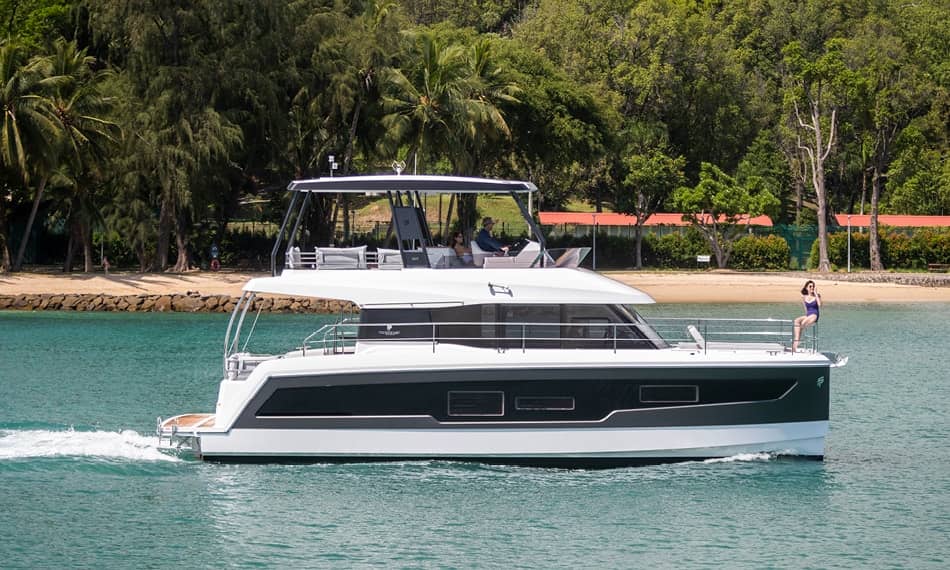
Photo credit: Fountaine Pajot
Monohull vs. Catamaran Maintenance
Depending on size, age, and type of hull construction, maintenance costs will vary, but when comparing two fiberglass sailboats of similar length, the catamaran typically costs more to maintain. That’s because there are two hulls to care for, two engines, connecting structures that align the two hulls, and an overall larger boat due to the catamaran’s greater beam. Hauling and launching a catamaran can be more expensive at many boatyards, as well.
However, smaller catamarans of about 20 feet in length or less are often more comparable and sometimes cheaper to maintain than a similar length monohull. That’s because cats are often lighter and suitable for keeping on a trailer rather than in a slip or on a mooring.
Catamaran vs. Monohull Cost
Compared to similar length monohulls, a catamaran will likely cost more than a monohull boat. That’s mainly because when you purchase a 40-foot catamaran, you are buying two hulls and two engines, but you are also buying a bigger boat that typically has much more volume. In the case of a 40-footer, you end up with a boat that has a large saloon and three or four private cabins, whereas in the monohull, the saloon is smaller and you’ll have three smaller sleeping cabins. Annual maintenance will also be greater, as described above.
Among smaller catamarans and monohulls, pricing will vary, and a lightweight beach cat may be less expensive than a heavier monohull keelboat of similar length.
Catamaran vs. Monohull, Pros and Cons
Depending on a variety of factors, there are plenty of catamaran and monohull pros and cons. These are some to keep in mind when comparing the two boat types.
Catamaran pros
• Comfort . On a cruising designed catamaran, two hulls with a wide beam create a stable and comfortable living environment with open spaces and plenty of standing room.
• Speed . Smaller, lighter catamarans are speed champions, especially in a moderate wind and modest waves. Cruising cats are often fast when sailing at reaching angles.
• Maneuverability . When equipped with two engines, a catamaran is highly maneuverable under power.
Monohull pros
• Upwind sailing . Although catamarans are often faster when sailing in a straight line, monohulls typically perform better against the wind.
• Self-righting . Except for unballasted monohulls that rely on crew weight for stability, the ballasted keel of a monohull prevents capsizing in most circumstances and the keel makes the boat self-righting.
• Maneuvering under sail . Monohulls turn more easily due to their shape, maneuvering in close quarters or tacking when sailing against the wind.
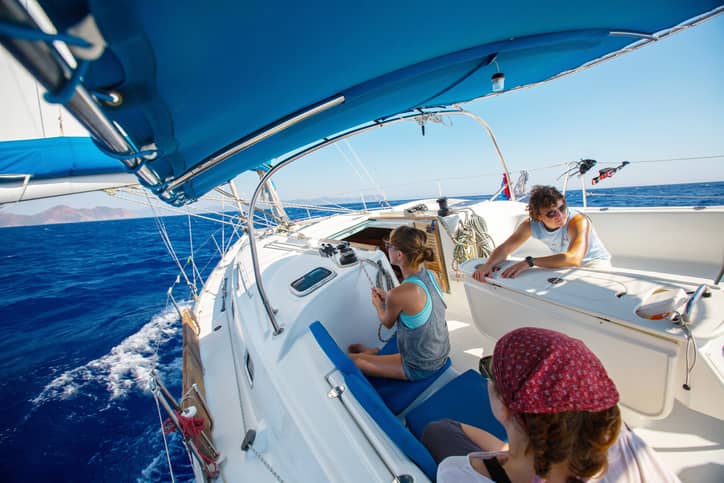
Catamaran cons
• Lack of feel when steering . Except in lighter, more performance-oriented catamarans, the broad platform with two rudders and two hulls sometimes isolates the sailor and provides little feedback through the helm when under sail.
• Sailing against the wind . Upwind sailing is generally not a catamaran’s best point of sail, but its straight-line speed can be such that it may arrive quickly at its destination, even though you will have traveled much farther than in a monohull.
• Pricing . Catamarans are typically more expensive than monohull boats due to their two hulls and other required build components and complexity.
• Not self-righting . Thanks to its wide beam and two-hull design, a catamaran is more difficult to flip, but it is not designed to right itself except for small beach cats where the crew can use their weight to re-right the boat.
Monohull cons
• Weight . Most monohulls have thousands of pounds of weight in the keel for ballast that is vital to its stability but can degrade performance.
• Wave motions . Monohull boats are much more susceptible to rolling wave motions.
• Cabin . With the monohull cruising design, you'll typically find a darker interior with smaller port windows and fewer space options.
• Heeling effect . Monohulls will heel over in a moderate wind, which is normal but often uncomfortable for newer sailors.
Written By: John Burnham
John Burnham is a marine editor and writer with decades of journalism experience as Chief Editor of boats.com, Sailing World, Cruising World, and other boating websites. As a competitive sailor, he has led teams to world and national titles in the International One-Design, Shields, and other classes. Based in Newport, Rhode Island, John is a PCC leadership coach, a member of the America’s Cup Hall of Fame Selection Committee, and a past board member of Sail America and US Sailing. For more, see johnsburnham.com .

More from: John Burnham
Related Articles and Guides
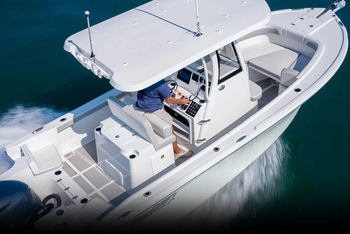
14th Apr 2024
Best Small Center Console Boats Under 25 Feet
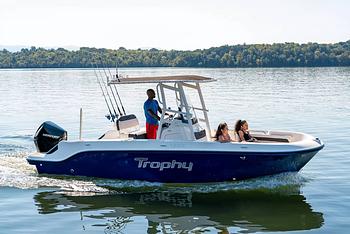
7th Apr 2024
Best Cheap Fishing Boat Brands, Affordable to Cheapest of All

30th Mar 2024
Best Boat Navigation Apps for Smartphones
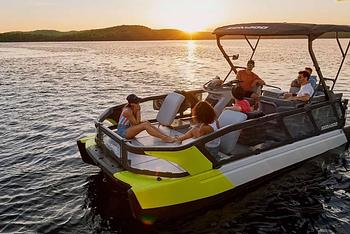
29th Mar 2024
Best Jet Boat Brands Among All Types of Small Craft
- Explore Rightboat
- Boats for Sale
- Boating Articles
- Buyers Guide
- About RightBoat
- Sell Your Boat
- Boat Selling Advice
Enter your email to keep up to date with the latest news
Join for free
Sign up now for free and discover how easy it is to keep up to date with THE latest boats for sale. Find your right boat, and tailor your voyage to finding your next boat.
Benefits of becoming a member:
- Set up tailored alerts
- Personalise your experience
- Download full specifications and broker details
- Keep tabs on your favourite boats
Are you a broker? Join as a Broker
Rightboat - join for free.
Do you have an account already? Login
Save this search
Save your search and receive new boats in your email..
You can unsubscribe from your alerts whenever you like. By pressing the button you accept the Legal Terms and conditions

- Allures yachting
- Garcia yachts
- Dufour yachts
- Fountaine Pajot Sailing Catamarans
- Outremer catamarans
- Catana catamarans
- Garcia Explocat
- Dufour catamarans
- Aventura catamarans
- NEEL Trimarans
- Allures Sailing Catamarans
- Fountaine Pajot Motor Yachts
- Garcia trawler
- Beneteau Motorboats
- Aventura Power Catamarans
- Yacht school
Sailing technique on a catamaran: the transition from mono to multi
The growing popularity of catamarans among yacht owners is understandable. Kats are becoming more reliable, sophisticated and easy to operate while offering an extremely high level of comfort.
We present to your attention a series of publications for those who have decided to transfer from a monohull yacht to a catamaran. Constructor Nigel Ayrens reflects on the difference in managing mono and multihull.
The growing appeal of boat sailing, which has a lot of "living space", means that one day the monohull yachtsman may have to think about completing his skills - and learning how to sail.
Usually such a need arises for large families or a group of friends who are tempted by the idea of renting a catamaran on a charter and go on a paradise journey. For any savvy skipper, the transition to a cat should not be a big problem. But the management experience is different and deserves to be familiarized with it.
Overview and visibility
Sitting for the first time at the helm of a catamaran ready to sail, you can experience a slight panic. After all, all this space around inevitably imposes some restrictions on the viewing capabilities.
If you are on a boat that has separate rudder stations for port and starboard, you may find that you have a wonderful view forward and backward. But looking to the side through the superstructure in the middle is as convenient as looking through a brick wall - in other words, you have no idea what is happening on the other side.
Yes, most of the actions during unmooring take place from the side of the pontoon. So you need to start from here - be able to see what is going on and communicate easily with your mooring staff.
If you have a boat with a high helm, you can see for miles. And, of course, you will get an excellent view of the mooring operators and the movement of the vessel in relation to the pontoon (although sometimes the mooring personnel hidden behind the saloon roof overhangs may not come into view).
Wind drift control
You probably took into account that a catamaran with its superstructures is very susceptible to wind drift. Most of these boats have ballastless keels. And while it's not the most efficient device for walking quickly upwind, it still has enough footprint to keep the kat from blowing away when you maneuver under the motor.
While the tendency to drift and the limited vision may seem a little intimidating, there is one option in the cut that makes the sailor's life much easier. Having two engines, especially well spaced apart, gives you a secret weapon to make even a beginner look like a pro.
It is also worth noting that the rudders on a regular cruising boat are probably slightly smaller than you would like for low speed maneuvering. This decision is often driven by the desire to reduce draft as much as possible - and the cost of the entire structure as well.
Maneuvering with two motors
In fact, armed with two motors, you can forget about the steering wheel, and just put it straight, maneuvering at low speed. This can avoid this frustrating mooring experience when you have to go full speed ahead, hoping that the boat will react in time before you hit the pier astern. This trick can work well on a monohull with high keel, feathers and shallow water, but on a kata it is best to resist the temptation to do something like this.
Now that you are ready to leave the dock, look at the strength and direction of the wind - just like any other boat. If you are on a charter catamaran, you may find yourself closely moored among other boats. And you have to gently move sideways to get out into the open.
Using 2 motors, you can get out of the “jammed” place in the marina without a paddle wheel. It is enough to start up the engines, until you get up so that you can get out cleanly. However, do not forget that this action will turn the boat around, and the stern will move towards the dock - so it needs to be well protected with fenders.
Unmooring on a spring
If the boat does not have a thruster, you may need to sprint the boat out from the bow through the mooring cleat somewhere in the stern area. The spring is then wound back onto the nose, and is released in the process by selecting the running end.
Slow forward motion while the boat is supported by this spring will allow the stern to be pulled away from the dock.
If all goes well, when the boat is 45-50 degrees away from the dock, you will be able to go astern into the open space by releasing the spring and retrieving it on board. Be careful, because things can go awry if the two sides of the cable twist together - just a couple of turns - and friction stops the end from running. Even an end passed through the heavy metal ring of the dock can get stuck and ruin your day.
Remember to attach the fenders to the bow before starting this maneuver. Because the bow may be strongly pressed against the dock when you turn on the throttle.
Before you wind up thinking about the hardships of getting out of the marina for the first time, think that this is probably the hardest thing in the coming week. Try to catch the moment when the wind has died down. Too strong wind will make the whole operation much more difficult. And the possible consequences if something goes wrong are more unpleasant.
Once you've finally stepped out of the marina into the open water, you can relax and take some time (and space!) To learn the ways of this strange new beast. Write different pirouettes where you can easily make mistakes - without the risk of damaging anything. Including self-esteem.
What should and shouldn't be done
- Observe where the wind comes from, as drift on the kata is more important.
- Practice using two motors for taxiing - the feathers on most cruising catamarans are small and less efficient at low speeds.
- Look at the place where you will have to exit from a different angle - for example, from another pier.
- Don't let the springs get tangled - friction will stop the end movement.
- Do not try your first maneuvers in strong winds. In the tropics, for example, the waters usually subside in the evening.
- And don't forget that unmooring is probably the most difficult maneuver you have to do right now.
A source: Yachting world / Translation: Dmitry Bushuev
News and articles

Interparus in touch! Yachts with a classic design are becoming more and more rare guests in marinas, they are less and less ordered from shipyards and taken on charter. Despite this, demand remains quite high. Grace III is a perfect example of what an updated classic yachting has to offer!

The sailing catamaran Lucia 40 will be the first boat to use Volvo Penta's new electromobility technology.

Applications with alarms and home control will not surprise anyone. And what about the full control of the boat's systems?

Log in or Sign up
You are using an out of date browser. It may not display this or other websites correctly. You should upgrade or use an alternative browser .
Hobie/J24 Trimaran Conversion
Discussion in ' Multihulls ' started by Delane , Apr 17, 2005 .
Delane Senior Member
I've just bought a j24 and have a Hobie 20. I'm thinking about converting the J into a Tri. The thought is to use the rear traveler as an area to tie in a spar and go under the hull on the front end jsut behind the mast. I think this would be a very fast stable boat. I love speed with a little comfort. Any thoughts out there?
DaveB Senior Member
Great to think about ideas like that, but it might be more involved than you realize... Might wind up costing you more than it would to go out n' buy a tri... after trading in what you've got n' buying used of course... I think that tri hulls are designed knowing that they will have the outer hulls for stability... A J24 isn't... it's pretty beamy in comparison so it has form stability... it also has a whopping big keel! To take advantage of the hulls you'd want to increase the size of your rig which isn't trivial... new sails, new mast, new standing rigging, possibly re-inforcing required... The keel'd have to go too... I guess it just seems like a lot of work for a non-ideal solution... A purpose built tri like a dragonfly'd perform much better... Also, your boats are popular classes and by modifying them as required you'd destroy the resale value... If I were you I'd think about selling them and buying a used tri... dragonfly, farrier or something like that... Just my two cents... Dave
Doug Lord Guest
j24 tri I think Dave is 100% right. In addition, the beam to length ratio of the j24 hull will not be very good compared to a boat designed to be a tri keeping speeds pretty slow.
yokebutt Boatbuilder
Somebody did mate a wabbit with a hobie 16 a few years ago, don't know how the offspring turned out though. Yokebutt.
mackid068 Semi-Newbie Posts Often
Not worth it. 2 boats are certainly better than one.
Thanks guys for your imput. I know the ration isn't close to ideal, and planned to remove 90% of the keel and add a foam and fiber stub of maybe 2 feet and use daggers on the Hobie hull for pointing. Without changing the mast and reducing the weight of the keel (900), figure I could at least reach speeds of around 10 knots up and 18 down. The center hull minus the keel should plane at around 12.
CT 249 Senior Member
Reducing the wieight of the J keel by 90% saves....what about 800 lb? Adding the weight of the Hobie 20 and crossbeams of sufficient strength adds what, 350 lb and a lot of wetted surface area? So you've taken 550lb out of the boat, BUT added foils that will be very highly loaded (only the lee one will be in the water and it was designed for much less sideforce at higher speeds) and windage and wsa, and you expect to increase speed? Umm, sorry, I've seen a couple of attempts at this and they are utter failures. Re speeds; a Farrier F720 trimaran is about the same pace as a J/24 all round the track and it has a much slimmer main hull and bigger, better outer hulls, plus a better rig IIRC. The J/24 rig is not much chop when it comes to low drag sailing which a tri needs. The J/24 hull is a fat little thing, it's nothing like a real tri hull.
do what you like, but post pics...PLEASE!!
Chris Ostlind Previous Member
Hobie Tri There's a guy near Perth, named Barry Sanders, who was building a wild thing tri from a sharpie skiff, I believe, and a Hobie 18. This boat has yards of aluminum structural rigging and is set to run with a dual H18 rig set as a schooner setup. I haven't seen or heard from him in a year or more, but I would hazard a guess that his stuff can be found with a Google of some sort. If that doesn't work you can post a query with the Multihull Boatbuilders site on Yahoo. Someone there will know how to find him. Chris
CT 249, thank you for the imput. I disagree about a F720 pacing around at the same speeds as a J24, and I'm pretty sure the H20 hulls can take side loads at any speed. I've had two on the wire a me at the hot seat, flying a hull in heavy seas to windward and just pounding the waves at 24 knots. I'm certain the H20 will take the loading of the J rig, especially when reducing the load with bodies on the windward side. I'm in the process now of determining the best location to bolt in the main cross members to the J hull. I plan to have the J hull projected out in front of the H hull to allow more initial loading (learned this from another site) and allow easier tacks. Also thinking a full batten main will help performance. Cris, thanks for the info. I'll try to find that guy, and let you know. Later Delane
lanekthomas Guest
I have effected a similar conversion of a 16 ft Lone Star mono and Hobie 16s. Speed is less than the Hobie 16, but greater than the Lone Star. Very pleased with the performance, just more weather helm than I care for.
Re "CT 249, thank you for the imput. I disagree about a F720 pacing around at the same speeds as a J24" You may well be right, but US Portsmouth yardsticks put the TT 720 at 79.X, and the J/24 at 80.X. So Portsmouth thinks they are the same speed. Most Australian races give the TT720 a rating in that sort of speed and when I sailed the agent's TT720 we were about that pace and the Trailertri agent reckoned that was the normal speed. Ditto when I raced against TT680s and TT720s, mainly on a 26' Mull. I see that Mull is still rated faster than Farrier 25s in the biggest Australian race. Then again, a lightweight and modified TT720 rates very quickly. The TTs are wonderful, wonderful boat (I want one, I have advised friends to get one, I really enjoy sailing them) they are just an older cruiser/racer and that is reflected in their performance. They are also pushing the limits in terms of having an unusually beamy main hull, but it's still much, much narrower than a J's hull. Considering how much importance multi designers like Nigel Irens, Peteghem/Proviot and Dick Newick place on having a narrow beam/length ratio, it would seem highly unusual that a much beamier boat would go all that well. "I'm pretty sure the H20 hulls can take side loads at any speed." Sure, I was just wondering about the sideloads of the rig; not structurally, but in terms of overloading the optimum lift/drag ratio for the Hobie centreboards which are smaller than the sort of board you'd put on a boat with the J style of rig.
The start of the J conversion is near with most of the other items finished. I've completely refurbished nearly everything on the boat to include electrical, wood, tabernacle deck step, spreader thru bar mod, paint, etc. I've cut the cross bars to 18ft each. Next is fabricating a jig to accurately mark the locations for cutting the holes for the cross bars. Have a plan and drawings of how to support the cross bars through the hulls. No less than bullet proof will work since I ocean sail to local islands in varing conditions. The aluminum pipes are 5.5 inches accross and 3/8 thick, each weighing about 90lbs. Considering drilling litening holes to reduce weight by 25% and yet maintain at least 80% strengh. Rear cross bar just under the companion way and the other just in front of the compression post. Next remove the keel and seal up the keel stud holes, and launch with the approximate weight of items not on board to measure the new waterline. This will determine exact hole locations for the bars and mounting distance to hulls. My guess is it will float about an inch higher than before with a reduction of about 650lbs. Then fabricate a foam and fiberglass foil that will help with leeway and in addition dagger boards for the outer hulls. I welcome any helpful suggestions.
tspeer Senior Member
Put the saw down and step away from the boat. Keep your hands in the air, and nobody gets hurt. You're missing the whole point of a trimaran - how to have a narrow hull without the excess weight of a heavy keel to keep it upright. Converting a J24 to a trimaran is preserving the worst features of both types. You have the high wetted surface of the floats and the beam of the monohull. You've refurbished the J24 - you now have a nice monohull. If you want a trimaran, sell the J and get a trimaran. Despite the common cliche, a trimaran is not really "a monohull with training wheels." These mono-to-tri conversions inevitably end up as dogs. And they ruin a perfectly good monohull.
- Advertisement:
frosh Senior Member
Trimaran conversion Hi Delane, excellent advice from Tspeer; take it before it is too late. When you find out after spending your hard earned money and countless hours of work, that the new boat doesnt really work you wont be able to give it away. It is inevitable that such boat wont come remotely close in performance to any Farrier Tri. Either get one of those, or build one if you want a construction project, or stay with a J24.
24ft Wa'apa / Hobie 16 mashup / shelter pod
Hobie Cat Lateen Conversion
Where do I start? Build a Trimaran from an Australian Surf Boat and Hobiecat
Hobie 18F centerboard box repair?
Hobie Hulls (buyer's remorse)
Cat from Hobie Tandem Island amas?
Hobie 14' & some stupid kid
Lateen rig on hobie cat.
Does anyone in south-east Australia want a free set of Hobie 20 hulls and beams?
Diy wing seats for hobie 16.
- No, create an account now.
- Yes, my password is:
- Forgot your password?


IMAGES
VIDEO
COMMENTS
Water surface will also be higher and the monohull will not be at ease being pushed much faster, so main hull waves will limit maximum speed compared to that of an equivalent length trimaran. Upwind performance will vary a lot, depending on the final choice of amas, how broad is the central hull and the windage it creates.
monohull to trimaran Hi Tom, I was just searching for the same issue. My boat a Beneteau Oceanis 390 is quite comfortable but slow (max 8 knots). My idea was to convert it into a trimaran using pre-manufactured parts. Got to the f-boat site with their folding beams. I'm at the moment checking out that posibility!
The images shown below represent a working versions of a slender monohull conversion to very functional trimarans. If the base hull is selected carefully, you are capable and willing to make rather extensive mods to the original hull, and have more than a passing understanding of how to balance and properly engineer a boat of this type, it can ...
Converting monohull into trimaran. Discussion in 'Boat Design' started by sailor182, Jun 5, 2013. Joined: May 2013 Posts: 18 ... Why convert a mono hull? In my area all the harbors are at capacity with a ten/fifteen year waiting list so there are a lot of decent sailboat on trailers going for cheap. Interior space wouldn't be too shabby ether.
It is difficult to give an 'overall' rating, so lets break it down point-by-point: Stability:Inherently, a multihull is more stable due to its width. While sailing, a trimaran does heal a little, somewhere in between a monohull and a catamaran. While at anchor, our trimaran does rock a little, more so than a catamaran, but less than a monohull.
Our small tri friend Stefano M. sent me links to the following YouTube videos. They feature a J-24 sailboat converted into full-blown trimaran. The sailor (s) responsible for this appear to have done a fine job. Converting a monohull into a trimaran has certainly been done before. But it's not for the faint of heart :-)
Top stories. A radical new foiling hull design claims to combine the efficiency of a trimaran with the space of a monohull — Hugo Andreae takes a look at the world's first trimonoran motoryacht. Award-winning Turkish yacht designer Baran Akalin has combined forces with Dutch engineer G. Jelle Bilkert to create what they describe as the ...
Corsair trimarans, and most others, have a max heel angle of 12-14 degrees depending on the model. That's "flat sailing" in monohull terms. And it means that rudders and daggerboards keep a reassuring grip and the speed therefore feels more effortless on the helm. That surefootedness transfers over to your crew - they'll detect the ...
Trimaran sail trim. One of the biggest differences between a cruising monohull and a multihull is how the mainsail is trimmed. Leech tension on a yacht is often largely controlled by the kicker and the backstay, while the mainsheet sheets the mainsail in and out, predominantly controlling the angle of the boom to the centreline, and there may be a short traveller.
For their size, trimarans can punch well above their weightin speed, cruising potential, and fun. Monohull sailorTheo Stocker gets to grips with how to handl...
Trimaran Conversion on the Cheap. Discussion in 'Multihulls' started by Chuckles, May 4, 2015. Page 1 of 2 1 2 Next > Joined: May 2015 Posts: 4 ... In many ways a cat or tri is much better than a monohull since it will not heel nearly as much, adding to the worry of a newbie. So consider making a suitable center hull, with a comfortable (even ...
I like them both. Currently we own a monohull (cruiser), a catamaran (racer), and a trimaran (daysailer). They are all great for different jobs, and I like them all. The cat is the most fun to sail, but is also the smallest and is a one person very physical boat to sail. The trimaran is probably the ideal day sailer, fast, good in light air, can stack a lot of people on it, low loads, rewards ...
This is a video of the first sail on my trimaran. The winds were light (3 to 5 knots). The boat tacks effortlessly and the tiller is perfectly balanced. Subs...
While trimarans do provide a decent degree of livability, they fall short of catamarans in two regards. First, they heel more than cats, making it difficult to do things like cooking on board. Second, they support much less load than catamarans. To put things into perspective, some 45 feet (14 meters).
The most impactful change from a monohull to a multihull is that everyday life moves up a storey or two. The location and flow of spaces and rooms and people are critical to defining the heart of a home. The heart of the home shapes how the residents and guests spend their time. For any liveaboards or long-term cruisers, just this difference in ...
The monohull's genesis lies in the early days of human seafaring. Traditional cultures from the Mediterranean to the South Pacific have all used some form of monohull craft for fishing, trade, and exploration. The monohull's sleek, single-hulled design, characterized by a deep keel and distinct bow and stern, offers an efficient shape for ...
The below creation was just featured in Norwegian sailing media. Apparently a german project named "Mia". The report says that the centerhull used to be a Dehler 41DS. Pics shot by Helge Iversøy at Ponta Delgada. I have seen lots of discussions about using a monohull as the basis for a trimaran. This is the first time I have actually seen such ...
Number of Hulls, Performance & Stability. As its name implies, a catamaran features two parallel hulls, while a trimaran three hulls. The hull count influences the boat's stability, maneuverability, and overall performance on the water. Catamarans are widely recognized for their exceptional stability and sailing performance.
Myth 3: There is more cabin space on a monohull. Err.... This one is actually true. The monohulls invariably win on space below deck. Trimarans suffer on two counts. 1. The central hull is typically narrower to aid sailing performance. 2. The boats are shallower as they sit on, rather than in, the water.
Catamaran vs. monohull power. A monohull under auxiliary power may be faster than a catamaran in certain conditions, like powering against a strong wind. In other wind and wave conditions, the catamaran is often faster. Also, with an engines on each hull, the cat is often much more maneuverable in close quarters or at the marina.
A trimaran is an integrated system - it's not a "monohull with training wheels". If you try to convert a monohull into a multiull, you get the worst of both worlds. The unfortunate fact is that you can't build a boat for less than buying a used boat that does what you really want.
We present to your attention a series of publications for those who have decided to transfer from a monohull yacht to a catamaran. Constructor Nigel Ayrens reflects on the difference in managing mono and multihull.. The growing appeal of boat sailing, which has a lot of "living space", means that one day the monohull yachtsman may have to think about completing his skills - and learning how to ...
You're missing the whole point of a trimaran - how to have a narrow hull without the excess weight of a heavy keel to keep it upright. Converting a J24 to a trimaran is preserving the worst features of both types. You have the high wetted surface of the floats and the beam of the monohull. You've refurbished the J24 - you now have a nice monohull.